

How to Write a Good Scholarship Application Letter (6 PDF Sample Examples)
Published: 09 Sep 2020 Scholarship Application 191,139 views
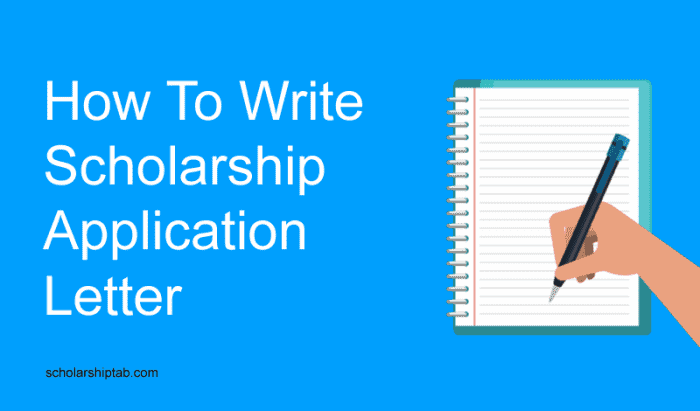
Are you uncertain about how to write a scholarship application letter? You are in the right place. We will teach you how to write a killer scholarship application letter. Over 6 PDF application letter sample examples available for download. After examining the scholarship cover letter, we will then check out some scholarship letter samples.
We will discuss
- What is a scholarship application letter?
- Parts of a scholarship application letter
- Scholarship Letter Format
- What not to include in a scholarship application letter (Scholarship cover letter)
- Sample Application Letter for scholarships
- Scholarship Application Letter sample pdf
- Scholarship Application Letter samples Templates
Application Letter for Scholarship in College
Application to principal for grant of scholarship.
- Application Letter for financial need
- Application letter for master's degree
- Application letter for university
Checkout ongoing scholarships for internation students to study abroad
WHAT IS SCHOLARSHIP APPLICATION LETTER
So, a scholarship request letter is a cover letter that indicates your interest in a scholarship and ways in which the award would help you achieve personal and professional goals. It is a letter requesting scholarship consideration.This type of letter is usually required along with other important documents by the University committee. The purpose of the scholarship application letter is to convince the committee that the candidate in question is highly eligible for the award. It is an instrumental tool in seeking financial backing. Further in this article, you will encounter scholarship application letter sample ad hoc. Checkout best way to apply for scholarships and get taken
PARTS OF A SCHOLARSHIP APPLICATION LETTER
As you must have seen in other articles , documents such as a scholarship essay or scholarship CV are drafted with caution, organization and professionalism. A scholarship application letter is not an exception. In order to capture the attention of the committee deeply, a scholarship application letter must be written in a well - structured manner. An application letter for scholarship pdf will be provided (scholarship cover letter pdf). The following parts make up an appealing scholarship application letter:
Contact Information
Self introduction and a milestone achievement.
- Middle Part
- Key details of you and reason why the committee should choose you
- Expression of passion and reason why you want the scholarship
- Call to action paragraph
- Best Regards
Just as every formal letter contains the contact information of the sender and the receiver, the same applies here. A scholarship application letter should contain the name, street address, telephone and email of the sender (at the right side). Afterwards, the name of the organization, street address and zip code are placed on the left side when writing an application for scholarship request
First impression matters a lot and so is the first paragraph of a scholarship application letter. The first paragraph should indicate your zeal and your understanding of having such an award. It would whet the appetite of the reader. Start with a significant achievement that shows how much you value this particular course of study.
Key Details about Yourself and reasons for Choosing you.
A scholarship cover letter for students should entail relevant information about your achievements, the role models you look up to, your struggles to attain the scholarship and the victory you would achieve for getting this scholarship.
Expression of your passion
In this paragraph, the committee wants to encounter the zeal in attaining the scholarship and perhaps the sacrifices you must have made. This doesn't mean that you want to sound desperate. But you are expected to express how much you want the award in a constructive manner.
Call to action
In a letter to scholarship committee, a call to action paragraph is the last but not the least important. Do you want the committee to call you back? Then you just have to say it. Ask for a meeting arrangement and leave the notable impression that you have more to discuss.
LETTER FORMAT FOR SCHOLARSHIP APPLICATION
Let's reiterate a point here. The content of the letter is as important as the structure of the letter. This means the format has to be set in a way that makes the content edible and appealing. It can also serve as a scholarship letter format for school. So how about you follow the few guidelines below:
- Use the correct spacing: 1 or 1.5.
- Don't be tempted to use justification. Left side align is easy on the eye.
- There should be one - inch margins for some white space and friendly impression.
- When it comes to the paragraph, there should be double spacing between them.
- Fonts like Calibri, Arial and Times New Roman are welcome.
WHAT NOT TO INCLUDE IN A SCHOLARSHIP APPLICATION LETTER
To be more certain that you write only within the context of what is needed, here are some traps you just avoid.
1. Don't include your weaknesses
This is an opportunity to zone in your main strengths, achievements and skills. This is not the stage where you explain your weaknesses. Just like the example of letter of intent for scholarship below, focus on matching your strengths with some vivid examples.
2. Don't use an informal tone.
In the process of appealing one's heart, you may want to shift to an informal tone. That shouldn't happen. Your letter has to be precise, clear and formal. The scholarship letter examples below will give you a hint
3. Don't submit without proofreading
In a letter of interest for scholarship, it is essential that you check for grammatical errors and rectify them. One way you can achieve that is by asking someone to read the letter. That way you will have a more objective viewpoint.
4. Don't add unnecessary information.
You may find yourself adding unnecessary details that would only make your letter sound lethargic and unappealing. True, it is a personal letter for scholarship. However, details such as height, family tree or any other irrelevant information should be avoided.
5. Don't hide your need for financial assistance.
You may conclude that expressing your inability to pay tuition fees would sound desperate. Wrong! A scholarship is meant to alleviate a financial burden. So asking for financial assistance is highly expected. So an application letter for scholarship financial assistance is just appropriate. Relate your strengths and academic achievements. In the middle part of the scholarship application letter, you are free to explain how beneficial the organization's financial assistance would be to you.
Checkout how to get scholarship to study abroad
EXAMPLE OF APPLICATION LETTER FOR SCHOLARSHIP
Here is a sample scholarship application letter.
Mary Rowland
23, Streetview, Los Angeles,
California, USA,
[email protected]
+565 325 36771
7, September 2020
Admission Board,
Quebec University,
Lilyland Park,
Quebec, Canada
Dear Admission Officer,
I can't imagine any better opportunity to further my career in Marine Biology than this. So I am applying for a scholarship award for Masters in Marine Biology in the University of Quebec. This would be an added achievement to my victory in a 200 member school competition for Marine Biology. This would testify to my fervor for this field of study.
Ever since I was a kid, my parents would take me to all sorts of aquariums. Every time was a fascinating experience. But going back home never stopped my curiosity. I kept researching the nature and functionality of sea creatures. In time, I developed research and analytical skills, critical thinking and problem solving skills. Once, there was an elevator pitch competition with the title "The Impact of Whales in the Lives of Scuba divers". The topic sounded amusing and daunting at the same time. But my passion for Marine Biology never stopped me from giving it a shot. At the end, I was applauded for my great speech. In time, my presentation skills were furnished.
So shortlisting me for the scholarship award would be a privilege on my part as it would reflect on my grades, courseworks and projects.
Understanding the nature of sea animals and plants has propelled me to draw closer to high school students who are equally curious and craving for answers. So I took up full time as an aquarium tour guide. With this job, I shared my passion and enjoyed the satisfaction that pupils had after an interesting tour. However, my job provides a meager income. As much as I aspire to study Marine Biology, I would need financial assistance to bring my dream to reality. Therefore, I am humbly seeking monetary support.
How about we hold a meeting and discuss the impact the course of study would have on the next generations and the facilities that University has to contribute to the exposure of Marine Biology as a discipline?
Best Regards,
Mary Rowland.
SAMPLE SCHOLARSHIP APPLICATION LETTER PDF
So the above section of this article entails a sample scholarship application letter. For faster accessibility, we would advise you to download the scholarship request letter sample PDF so as to fully be absorb every step that has been applied. Dowload Sample Scholarship Application Letter
SCHOLARSHIP APPLICATION LETTER TEMPLATES
You may have a more specific purpose in mind when writing a scholarship application letter. The purpose could be to gain admission in college or in University, appeal for a financial need or application for masters. In any case, here are the following templates and letter intent sample for scholarship and their sources.
Here is an application letter for high school
Download scholarship application letter for high school
Here is a request letter for scholarship from students
Download application to principal for grant of scholarship
Scholarship Application Letter for financial need
Here is a “reason for applying scholarship” sample letter.
Download scholarship application letter for financial need
Scholarship Application Letter for Master's Degree
Here is a sample scholarship application letter for masters degree scholarships
Download scholarship application letter for masters degree
Scholarship Application Letter for University
The last application letter for applying scholarship
Download scholarship application letter for university
Striving to get a scholarship is a great goal to set. So kudos to you. With guidelines, tips and samples in the article, you will have no other choice but to succeed. Also you have been provided with a letter requesting scholarship consideration pdf. So write an application letter for scholarship confidently. However, that would not be the end of the scholarship application process. You will definitely be asked for a scholarship interview and even a scholarship recommendation letter. In any case, ScholarshipTab has all the answers. Simply subscribe to our newsletter and have a good digest of scholarship application strategies. Till we meet again.
Latest Blog Posts
- 30 Best Medical Universities In The US 2024
- Tips To Find And Apply For Scholarships Online
- 30 Best Study Techniques To Try This 2024
- 26 Best Country To Teach English 2024
- 26 Best Free AI Chatbot 2024
- 20 Best Countries To Relocate 2024
- 30 Best Countries For Tourism - Top Tourist Countries
- Canada Work Visa Application Process
- Best Scholarships
- Sanlam Actuarial Bursaries for South Africans 2025
- Bond University Vice Chancellor's Elite Scholarship 2024
- University of Sheffield Africa Scholarship for Postgraduate Students from Africa 2024
- Apply Now: Australian Government Research Training Program (AGRTP) Scholarship 2024
- Monash University Raydon Graduate Research Scholarships 2024
- Swansea University Eira Francis Davies Scholarship for Female Students 2024
- University of Greenwich Sanctuary Scholarship in UK 2024-2025 (Fully-funded)
- University of Leeds Masters Scholarships for UK Students 2024 Up to $7,000
Scholarship Tips
Scholarships by country to study.
- United Kingdom
- United States
- South Africa
- Netherlands
- New Zealand
Scholarships by Category
- Postgraduate
- Undergraduate
- College School
- Entrepreneurs
- Bachelors Degree
- Women Scholarships
- Fully Funded
Scholarships by Country of Origin
- African Students
- Developing Countries
Scholarships by Institution / Company
- Flinders University
- German Academic Exchange Service (DAAD)
- University of Edinburgh
- The World Academy of Sciences (TWAS)
Scholarships by School
- University of Melbourne
- University Of Queensland, Australia
- University of East Anglia
- University of Kent
- Privacy Policy
- Terms of Use
Scholarships
- Undergraduate Scholarships
- Masters Scholarships
- MBA Scholarships
- Ph.D Scholarships
- Fellowship Scholarships
- Fully Funded Scholarships
- F1 Visa Interview Questions And Answers
- Scholarship Application Letter
- Letter Of Intent For Scholarship
- Personal Statement For Masters
- Motivation Letter For Scholarship
- Scholarship Acceptance Letter
Other Locations
- Scholarships in UK
- Scholarships in Canada
- Scholarships for Nigerian Students
- Scholarships for African Students
- Study Abroad Community

How To Write a Scholarship Application Letter (With Template)
Scholarships provide crucial financial support for students pursuing higher education. A thoughtful, well-written application letter can help you make a compelling case to win a scholarship.
Key Takeaways:
- Tailor your letter to the sponsor’s requirements and highlight your relevant qualifications.
- Share details on your background, academic achievements, skills, goals and need for the scholarship.
- Use a professional format with clear organization and follow scholarship guidelines.
- Proofread carefully and have others review before submitting your letter.
Got No Time? A Quick Answer for You:
When writing a scholarship application letter, first review the requirements to understand what the sponsor is looking for. Introduce yourself and explain why you are applying in the opening. Discuss your relevant accomplishments, skills, goals and need for funding in the body. Conclude by thanking the committee and confirming your contact information. Use a professional format, proofread carefully and get feedback from others before submitting.
Let’s get started on crafting a scholarship application letter that showcases your unique strengths and passion. With a focused, engaging letter, you can increase your chances of securing funding for your academic journey.
What is a Scholarship Application Letter?
A scholarship application letter is a formal document where candidates can make a case for why they should receive academic funding from an institution, organization or individual.
The letter allows you to introduce yourself, share your background and interests, and highlight achievements and skills that make you deserving of the scholarship.
While specific requirements vary, application letters generally include:
- An introduction explaining who you are and why you want the scholarship
- Body paragraphs detailing relevant experiences, accomplishments, activities, and skills
- A closing inviting further discussion and providing contact information
The letter provides the opportunity to showcase your qualifications beyond what’s in your transcript and resume. A well-crafted letter can help you make a memorable impression and stand out from other applicants.
How to Write an Impressive Scholarship Application Letter
Follow these key steps when drafting your scholarship application letter:
1. Review the Scholarship Requirements
The first step is to closely review the scholarship requirements and organization’s website to understand what they are looking for in strong candidates.
Pay attention to:
- Eligibility criteria like GPA, field of study, etc.
- Mission and values of the organization
- Key attributes and qualifications they want applicants to highlight
This information will help guide what details you emphasize in your letter. You want to tailor the content to align with their priorities.
2. Craft an Engaging Introduction
The introduction paragraph is your chance to make a strong first impression. Include key details like:
- Your full name, field of study/major, and year in school (high school senior, college junior, etc.)
- Why you are excited to apply for this scholarship
- How the funding will support your academic and eventual career goals
This gives helpful context about who you are and why the scholarship is important to you.
Here is a sample introduction:
My name is Jennifer Smith, and I am currently a high school senior at Jefferson High School planning to attend Washington State University next year. I am very excited to apply for the Women in STEM Scholarship, which would enable me to pursue my dream of studying engineering and eventually designing renewable energy solutions.
3. Highlight Relevant Experiences and Achievements
The body paragraphs should focus on your strengths as a student and person. Think about the key attributes, accomplishments and skills you want to highlight that align with the scholarship requirements.
Be sure to provide concrete examples and anecdotes to back up the qualities you present. Don’t just say you’re a hard worker – describe your strong work ethic by listing related achievements.
Here are types of details to include:
- Academic achievements: GPA, honors, advanced courses, involvement in academic clubs related to your major.
- Extracurriculars: Leadership roles, sports teams, community service activities. Discuss skills demonstrated.
- Relevant work experience: Jobs and internships in your field of study. Explain what you accomplished.
- Unique skills and strengths: Language proficiency, communication/teamwork abilities, creativity, initiative, discipline, etc.
- Passion for your major/future career: When did you become interested? Share an experience that sparked your passion. Discuss future goals.
Ideally choose 3-4 focused paragraphs to make your case, rather than covering everything superficially. Quality over quantity.
4. Close With a Summary Statement
Wrap up your scholarship letter with a concluding paragraph that reiterates your enthusiasm and fit for the award. Thank the review committee for considering your application.
Also, include an invitation to contact you directly if they would like to discuss your application or request more information. Provide your:
- Phone number
- Professional email address
- Physical address (optional)
Here’s a sample closing paragraph:
Thank you for your time and consideration of my application. I am incredibly excited by the prospect of receiving the Women in STEM Scholarship and would love to further discuss my qualifications. Please feel free to contact me by email at [email protected] or by cell at 123-456-7890 should you have any questions. I look forward to hearing from you!
5. Proofread and Get Feedback
Before submitting your letter, be sure to carefully proofread for any errors or typos. Read the letter out loud to catch awkward phrasing.
It can also be very helpful to have mentors, teachers, and family members review your letter and provide feedback. A second set of eyes can catch issues you may have missed.
With these steps in mind, let’s look at a template and example scholarship letter to illustrate an engaging structure.
Scholarship Application Letter Template
Review this template when crafting your own scholarship application letter:
[Your Full Name] [Your Phone Number] [Your Email] [City, State]
[Scholarship Organization Name] [Contact Person Name and Title] [Address]
Dear [Contact Name],
Introduction paragraph: State your name, current grade/year in school, intended major, and why you want the scholarship. Share your academic and career goals.
Paragraph 2: Highlight your relevant academic achievements like GPA, honors, awards, and advanced coursework. Mention membership in academic organizations.
Paragraph 3: Discuss extracurricular activities and leadership roles that helped you develop important skills. Share related accomplishments.
Paragraph 4: Mention work experiences and internships in your field of study. Explain skills gained. Share what inspires your passion for your major and future career goals.
Conclusion: Thank the committee for considering your application. Provide your contact information and invite further discussion about your qualifications. Express your enthusiasm for the scholarship opportunity.
[Your Signature] [Your Full Name]
Scholarship Application Letter Example
Read this strong sample scholarship letter for a high school student applying to a local community organization:
Jennifer Smith 123-456-7890 [email protected] Springfield, MO
May 1, 2023
Springfield Women in STEM Scholarship Scholarship Committee 123 Main St. Springfield, MO 65000
Dear Scholarship Committee Members,
My name is Jennifer Smith, and I am currently a senior at Springfield High School who intends to study mechanical engineering at State University next year. I am thrilled to apply for the Springfield Women in STEM Scholarship, which would empower me to pursue my dream of becoming an engineer and innovator.
In high school, I have consistently maintained a 4.0 unweighted GPA while enrolled in multiple honors and AP courses. I am also deeply involved with the Robotics Club, serving as team captain for the past two years. In this leadership role, I have guided our team to win regional robotics competitions and demonstrate key engineering skills.
Beyond classes, I spend time volunteering as a tutor where I have helped dozens of classmates master concepts in math and physics. I also played junior varsity soccer freshman and sophomore year, developing my teamwork, discipline and communication abilities. Through these diverse experiences, I have become a driven, high-achieving student capable of excelling in a STEM degree program and career.
Most of all, I am deeply passionate about science, technology and using my skills to develop solutions to real-world problems. I have known that engineering was my calling since I built my first robot in 7th grade. Coming from a family of engineers, I have long been fascinated by renewable energy and want to help shape future green technologies. Receiving your scholarship would enable me to actively contribute to progress in this field.
Thank you for your consideration of my application. I can be reached any time at 123-456-7890 or [email protected] to further discuss my qualifications. I truly appreciate you taking the time to review my letter, and I hope to join the next class of women in STEM you support.
[Signature] Jennifer Smith
The Key Elements of a Strong Scholarship Letter:
- Customized Content: Tailor your letter to the specific scholarship requirements. Highlight the most relevant parts of your background.
- Well-Organized Structure: Use a professional format with logical flow between paragraphs. Easy to follow.
- Personal Details: Share information beyond just academic stats, like your interests, goals and financial need.
- Polished Writing: Avoid errors. Use clear, concise language that engages the reader.
- Attention to Details: Follow all scholarship guidelines precisely. Confirm eligibility. Submit by deadlines.
Pro Tips for an Exceptional Letter:
- Start early – Give yourself plenty of time to draft and refine your letter. Don’t wait until the last minute.
- Be positive – Avoid sounding desperate. Be gracious and focus on your qualifications rather than just need.
- Express passion – Let your enthusiasm and ambition shine through. Committees want motivated students.
- Proofread meticulously – Carefully check for any spelling, grammar or formatting errors.
- Get feedback – Have teachers, parents and friends review your letter before submitting.
- Send thank you notes – Follow up with thank you notes to show your appreciation.
FAQs About Scholarship Letters:
How long should a scholarship letter be.
There is no standard length – Scholarship letters can range from one to several pages depending on the requirements. Aim for 1-2 pages in most cases. The key is quality over quantity.
Should I send separate letters for each scholarship?
Yes, send customized letters – Avoid submitting the exact same generic letter for different scholarships. Tailor each one.
How do I list community service on a scholarship letter?
Highlight relevant activities – In a paragraph or bullet points, list service projects and how they allowed you to develop useful skills. Quantify hours served when possible.
Can I submit a scholarship letter by email?
Follow the guidelines – Some scholarships want printed letters while others accept email submissions. Carefully check and follow the requested method.
Is a scholarship letter the same as a personal statement?
They are similar but serve different purposes – The personal statement is for college admissions, while the scholarship letter is for financial award consideration.
In Conclusion:
A thoughtful, focused scholarship application letter allows you to introduce yourself beyond transcripts and resumes and make a compelling case for funding. By tailoring your content to the specific organization, highlighting your achievements and skills, and infusing passion throughout, you can craft a memorable letter.
Use the template and tips provided above to get started on your own application letter. Don’t underestimate the power of an engaging, personal letter to help you secure financial support as you pursue your academic and professional aspirations. With focus, planning and polish, your letter can get you one step closer to achieving your dreams!
Editor’s Note: Applying for scholarships can seem daunting, but breaking the process down into manageable steps will set you up for success. Remember to maintain a positive, gracious attitude and express genuine enthusiasm in your letter. Small personal touches and stories make a big impact. You’ve got this! 😊
With over two decades of experience, renowned scholar Dr. John Morris has become the #1 trusted global expert on winning prestigious government scholarships. Having personally received full funding awards from Germany, Brazil, Spain, the UK and Australia during his esteemed educational career, Dr. Morris now dedicates himself to helping disadvantaged students access the same life-changing opportunities through his motivational speeches at universities worldwide and highly popular Scholarships Office blog.
Similar Posts
Is scholarship for moms legit or a scam the real truth.
Scholarship for Moms is a legitimate scholarship platform that connects moms looking to further their education with potential scholarship opportunities. They do not directly provide scholarships, but partner with organizations that do. While free to use, be cautious about sharing personal information as it could be sold to third parties. Do research on their partners…

Is Earnest Scholarship Legit? The Truth Behind This Popular Program
Yes, the Earnest Scholarship is a 100% legitimate scholarship program that awards $50,000 annually to students pursuing higher education. The Earnest Scholarship has awarded over $925,000 to 185 college students since its inception in 2019. However, some lingering doubts persist about the scholarship’s legitimacy. Key Takeaways: The Earnest Scholarship is 100% Legit How the Earnest…
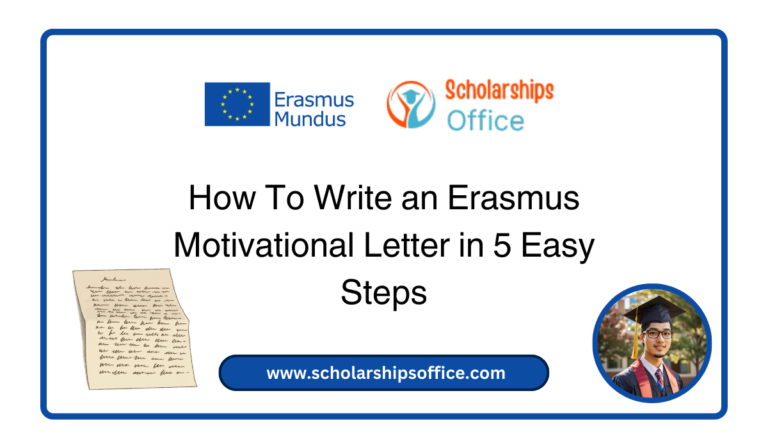
How To Write an Erasmus Motivational Letter in 5 Easy Steps
Got No Time? A Quick Answer for you:Writing a compelling Erasmus motivational letter is crucial for getting selected for the program. Follow these key steps – brainstorm your motivations, introduce yourself, explain why you chose the university/city, summarize your goals, and carefully proofread. Highlight your academic achievements, share details on the courses or research you…

Australia Accredited Sponsors for 482 Work Visa Sponsorship (2023)
Getting a work visa for Australia can be a complicated process, but finding an accredited sponsor can simplify things greatly. In this comprehensive guide, we’ll cover everything you need to know about Australia Accredited Sponsors for 482 Work Visa Sponsorship in 2023. Key Takeaways: Finding an accredited sponsor is a critical first step for the…
![scholarship application letter for high school Where Does Scholarship Money Go? [Ever Think]](https://scholarshipsoffice.com/wp-content/uploads/2023/09/Where-Does-Scholarship-Money-Go-1-768x448.png)
Where Does Scholarship Money Go? [Ever Think]
When you win a scholarship, the funds are typically sent directly to your college to pay for tuition, fees, and other educational expenses. Any leftover scholarship money after tuition is paid goes directly to you and can be used for additional educational costs like books, a laptop, or housing. Make sure to check with your…

How to Write a Winning Motivation Letter for the Erasmus Mundus Scholarship
Got No Time? A Quick Answer for you: The motivation letter is a crucial part of your Erasmus Mundus scholarship application. It allows you to showcase your accomplishments, competencies, goals and passion. Follow these key tips for writing an outstanding motivation letter: With careful planning and a compelling, personalized letter, you can maximize your chances…
Leave a Reply Cancel reply
Your email address will not be published. Required fields are marked *
Save my name, email, and website in this browser for the next time I comment.
Application Letter for Scholarship Request Sample: Free & Effective
In this article, I’ll guide you step-by-step through the process of writing a compelling scholarship application letter, including customizable templates to get you started.
Key Takeaways Understand the Purpose: Learn why a well-crafted application letter is crucial for your scholarship success. Personalize Your Letter: Discover how to tailor your letter to reflect your unique experiences and the scholarship criteria. Structure is Key: Follow a clear and effective structure to ensure your letter is engaging and easy to read. Highlight Your Achievements: Tips on showcasing your accomplishments without sounding boastful. Proofread and Refine: Understand the importance of revising your letter to eliminate errors and improve clarity.
Step-by-Step Guide to Writing Your Scholarship Application Letter
Step 1: research and understand the scholarship criteria.
Before you start writing, it’s imperative to thoroughly understand the scholarship’s requirements and objectives. Tailor your letter to align with the values and goals of the scholarship provider.
Step 2: Start with a Strong Introduction
Begin with a compelling introduction that captures the reader’s attention. Introduce yourself, mention the scholarship you’re applying for, and express your enthusiasm and commitment to your educational goals.
Step 3: Highlight Your Achievements and Qualifications
Detail your academic achievements, extracurricular activities, and any relevant experiences that demonstrate your suitability for the scholarship. Be specific and use examples to illustrate your points.
Step 4: Explain Why You Deserve the Scholarship
Articulate why you’re a deserving candidate for the scholarship. Link your personal, academic, and career goals with the scholarship’s objectives. Show how the scholarship will help you achieve your aspirations.
Step 5: Conclude with a Strong Closing Statement
Trending now: find out why.
End your letter on a confident note. Reiterate your gratitude for the opportunity and express your eagerness to contribute positively if granted the scholarship.
Step 6: Proofread and Edit Your Letter
Ensure your letter is free from grammatical errors and typos. A well-polished letter reflects your attention to detail and seriousness about the scholarship.
Personal Tips from Experience
- Be Authentic: Authenticity resonates. Share genuine stories and experiences that reflect your true self.
- Stay Positive: Even when discussing challenges, focus on how you’ve overcome them or what you’ve learned.
- Be Concise: Respect the reader’s time. Keep your letter clear and to the point without sacrificing important details.
- Seek Feedback: Don’t hesitate to ask a mentor or a peer to review your letter. Fresh eyes can catch errors and offer valuable insights.
Application Letter Template for a Scholarship Request
[Your Name] [Your Address] [City, State, Zip] [Date]
[Recipient’s Name] [Recipient’s Title] [Scholarship Committee’s Name] [Address] [City, State, Zip]
Dear [Recipient’s Name],
I am writing to express my earnest interest in the [Scholarship Name] offered by [Institution or Foundation’s Name]. As a dedicated student of [Your Field of Study], I am committed to my academic pursuits and am eager to overcome financial barriers to achieve my educational goals.
Throughout my academic journey, I have maintained a [Your GPA] GPA and have been actively involved in [List any relevant extracurricular activities or community service]. These experiences have not only enriched my knowledge but have also honed my skills in [Mention key skills relevant to your field or scholarship].
The [Scholarship Name] resonates with my personal and academic aspirations by [Explain how the scholarship aligns with your goals]. Your support would immensely help me [Briefly mention how the scholarship will aid your education and future plans].
Thank you for considering my application. I am enthusiastic about the opportunity to contribute to [Mention any relevant community/service goals aligned with the scholarship] and am committed to making the most out of the scholarship if granted the opportunity.
Sincerely, [Your Name]
Engage with Us
I hope this guide empowers you to craft a persuasive application letter that brings you one step closer to your academic and career goals. If you’ve found these insights helpful or have your own experiences to share, please leave a comment below.
We’d love to hear about your journey and any additional tips you might have for aspiring scholarship applicants!
Frequently Asked Questions (FAQs)

Q: How Should I Start My Application Letter for a Scholarship Request?
Answer: When starting your application letter for a scholarship, it’s crucial to grab the reader’s attention immediately. I began mine with a strong opening sentence that highlighted my enthusiasm and passion for the field I am pursuing.
For example, “As a dedicated and innovative student in environmental science, I am excited to apply for the XYZ Scholarship to further my goal of developing sustainable energy solutions.”
Q: What Personal Achievements Should I Include in My Scholarship Application Letter?
Answer: In your scholarship application letter, focus on achievements that are most relevant to the scholarship. In mine, I included my academic accomplishments, like being at the top of my class in relevant subjects, and extracurricular activities like leading a community clean-up project.
It’s not just about listing achievements; it’s about demonstrating how these experiences have prepared you for the scholarship.
Q: How Can I Show My Need for the Scholarship in the Application Letter?
Answer: Demonstrating your need for a scholarship can be done tactfully by sharing personal stories or challenges that have shaped your educational journey.
In my letter, I discussed how financial constraints have been a significant hurdle in my academic pursuits, and how the scholarship would alleviate these burdens and enable me to focus more on my studies.
Q: Should I Mention My Career Goals in the Scholarship Application Letter?
Answer: Absolutely! Discussing your career goals is vital. In my application letter, I clearly outlined how the scholarship would help me achieve my long-term career goal of becoming a renewable energy consultant. I explained how the specific courses and opportunities provided by the scholarship are aligned with my career aspirations.
Q: How Do I Conclude My Scholarship Application Letter?
Answer: The conclusion of your scholarship application letter should be compelling and memorable. I concluded mine by reiterating my passion and the alignment of my goals with the scholarship’s purpose.
I also thanked the committee for considering my application and expressed eagerness about the possibility of contributing to the field with their support.
Related Articles
Acing the “strengths and weaknesses” question in a scholarship interview, cover letter for student finance sample: free & customizable, email for scholarship application: how to write it right, 3 proven scholarship letters: secure your funding, 3 proven application letters for scholarship request, scholarships for black and african american students, 1 thought on “application letter for scholarship request sample: free & effective”.
This is Awesome and helpful..😉
Leave a Comment Cancel Reply
Your email address will not be published. Required fields are marked *
Start typing and press enter to search
Published In: Letters
Scholarship Application Letter Samples (Writing a Strong Application)
Students sometimes face financial constraints challenges, making it hard for them to afford tuition fees as stipulated by their school of choice. Nevertheless, several colleges, universities, and organizations offer scholarships to eligible students to assist them financially. If you are unsure about how to write a strong Scholarship application letter, this article will be very useful to you. in this article, we have provided a step-by-step guide on how to write a killer scholarship application letter, several samples, and templates that are readily available for download for your reference.
What is a Scholarship Application Letter?
A scholarship cover letter is a useful document that allows applicants to express themselves and deliver details about their goals and abilities. The scholarship letter usually serves as a formal introduction to the scholarship committee in addition to identifying you as the prime candidate for the specific scholarship being offered and is accompanied by the sponsoring organization’s materials.
A candidate justifies himself/herself as an outstanding student in overall studies and extracurricular activities to increase their chances of getting the scholarship through a scholarship application letter.
Sections of a Scholarship Application Letter (Format)
A scholarship cover letter should have different sections and paragraphs, with each part serving a different role:
Introduction
Provide your contact information, e.g., full names, address, and telephone number. Briefly introduce yourself to the scholarship committee or individual and add a milestone achievement to draw their attention.
First Paragraph
Your introductory paragraph should focus on your educational and career goals. Discuss your interests and show passion in the chosen area of course work. Give the funding organization all the reasons to choose to invest in you and help further your education. In simpler terms, show your worth.
Second Paragraph
The second paragraph needs to focus on your strengths. If you have participated in any extracurricular activities or you have had your hands on any community work, include it in this paragraph. Any academic accolades and awards should also be listed in this section. The second paragraph is usually all about selling yourself and your capabilities to the decision-makers of a scholarship.
Third Paragraph
In this section, talk about why it should be considered for the application. Speak directly to the individual or organization that is handling out the money in a professional manner. However, refrain from acting desperate for money, but rather, desperate for education. It is not wrong to talk about books, food, housing, and other school costs.
You can add the fourth paragraph if there is much to talk about.
Call to action paragraph
This is the last paragraph of your letter. Close strongly by highlighting any talents or special skills you possess and letting the funding company or individual feel confident that the course work will be completed. Restate your educational and career goals, and include a call-to-action statement.
Length of your cover letter
The letter should be around 1-2 pages maximum. Use font 12 and double spacing to make it easy to read through.Proofread your letter for clerical errors to ensure it is perfect.
How to Write
Cover letters written for scholarships may break or increase your chances of getting the scholarship you badly need. These letters are not very different from job application letters, but the idea is to market your capabilities to the scholarship providers. Thus, as a student in need of a scholarship, you need to understand how to write a good cover letter to improve your personal goals. The following are some tips on how to write an appealing scholarship application cover letter.
Explain why you are a good match for the scholarship
A well-written scholarship cover letter is an opportunity for you to overview your main strengths from an educational and professional point of view, your career development goals and plans, why you would be suitable for this scholarship, and how it will benefit you if selected. Ensure that you cover all this information using specific examples where possible.
Use a formal tone, a clear structure, and check spellings
Use a formal tone to write your scholarship application cover letter and employ a clear, concise, structured flow. Make sure to check and correct any spelling and grammar mistakes. Try asking another person with an objective eye to proofread your cover before submitting it to ensure you did a successful one. This also allows you to minimize the risk of any grammatical or spelling errors and helps you remove any unclear, redundant, or irrelevant information.
Match your cover letter to the context
Certain situations of scholarship applications require you to attach a cover letter. During the same time, you might be applying for admission to a program or an institution, or you may be applying for a grant or scholarship to cover your tuition fees or any other costs related to a program you have already been accepted to.
If your scholarship letter is intended for the initial case, begin your letter with a formal address and greetings, then do a short paragraph explaining your academic skills, strengths, and achievements. Your second paragraph should explain why you need the scholarship to fund your studies. The third paragraph should describe how the given program, project, or course you are applying for will help you meet your goals and objectives and how you will contribute during your studies. Your closing should be polite and formal.
If you are applying for funding for a program you have already been admitted to, consider these few aspects.
- Use a formal address and greetings, then a brief paragraph emphasizing your academic skills.
- The second paragraph should emphasize your financial situation and the reasons prompting you to need the funding
- Your third paragraph should be about your interest in studying in that particular institution and how much value you will get from it,
- Conclude your cover letter strongly by highlighting your strengths, academic skills, and goals to ensure your success.
What “NOT” to Include in your Letter
- Avoid adding your weaknesses: Do not mention any of your weaknesses. Since many people will be sending in their applications every day, you don’t want to come off as the weaker applicant, thereby reducing your chances of landing the scholarship.
- Don’t use an informal tone. Always be professional when writing the letter. You don’t know who will be reviewing your application, so make sure that you stick to a formal tone.
- Never submit your cover letter before proofreading. After drafting your letter, make sure to go through it several times to ensure it is free of any errors and that every detail is well captured.
- Avoid adding unnecessary or untrue information: Since you are trying to sell yourself, don’t exaggerate too much. At times, honesty is the best policy. Don’t lie; be simple and straight forward in your writing.
- Do not hide your need for financial aid: Remember why you are writing the application. Do not be embarrassed to ask for help.
Scholarship Application Letter Templates & Samples
Whether you are writing a scholarship application letter to gain admission to a university or college, appeal for financial assistance, or apply for further postgraduate studies, you can download and use our Free and premium templates and quickly customize them to fit your specific needs and objective. Download our templates today and get started on your scholarship application.
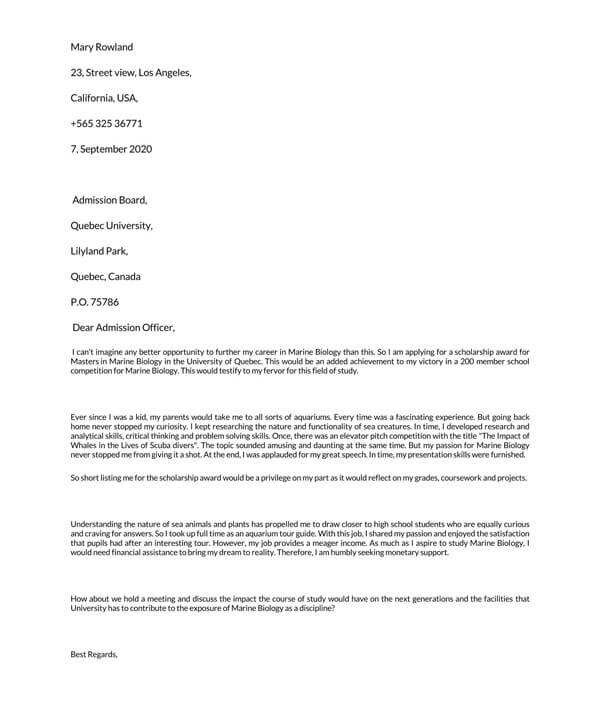
What do Scholarship Committees Require from Applicants?
Generally, scholarship committees look for some or all the following qualities in an ideal applicant.
- Candidate’s motivation and seriousness in the chosen field of study
- A detailed description of the specific course work or area of study
- The creativity and originality of the letter
- Leadership skills of the candidate as well as their emotional stability
- An applicant’s ability to collaborate with others and the desire to excel.
Tips for a Strong Application Letter
Here are a few tips to help you write a strong scholarship application letter:
- Explain why you are the perfect candidate for the scholarship: remember that you are trying to convince the scholarship committee that you are the perfect candidate for the scholarship. Convince them why they should choose you.
- Use a formal tone when writing and ensure that your letter has a clear structure and is free of any grammatical errors
- Write a great cover letter to go with your application letter: After drafting your application letter, write a great cover letter to act as an introduction and an invitation to review your application.
Many students fall under the category of those who are eligible for a scholarship. They may have excellent academic transcripts, or a list of extracurricular activities to boast about or a list of talents and hobbies. Whether you have those things or not, scholarship committees look for something else. That is students who have overcome challenges and major struggles, students who are leaders in their community, and those who have hobbies. It is a great idea to submit a scholarship application letter as it is your opportunity to think about how you can make yourself stand out from the other applicants and be selected for that scholarship sponsorship.
Related Documents
- Applying For Scholarships
Write a Killer Cover Letter for a Scholarship in 2023 (w/Example)
David Jul 24, 2022

Get our best scholarship practices, insights & tips delivered to your inbox
Thank you for subscribing!
It’s easy to get put off by scholarship applications that require a cover letter. Cover letters may seem annoying but there is a bright side here. A simple letter gives you another opportunity to convince the scholarship committee that you deserve to win the award.
So how do you start? What should you include in the letter? How should you end it? In this post, we’ll answer all these questions and we’ll even provide a sample letter that you can use as a template in the end.
What Is a Cover Letter?
Let’s start with the basics. A cover letter for a scholarship is similar to a cover letter you’d submit for a job . What does that mean exactly?
It’s simply a letter you write to the scholarship committee. In the letter you should explain what makes you a great candidate for the award. You should also talk about how the scholarship will help you reach your educational and career goals .
The fastest path to earning scholarships
Simplify and focus your application process with the one-stop platform for vetted scholarships.
The scholarship committee wants to find the most fitting students to invest their money in. Make them see the reasons why they should they invest in you.
Why a Cover Letter?

Whether you have those things or not, many scholarship committees look for something else. They look at students who have overcome struggles. Students who are leaders in their community. And students who have unique hobbies. Your cover letter is the place to show off your unique self.
Although not every scholarship application requires students to submit a cover letter, when they do, it’s a great idea to submit a great one. Use the opportunity to think about how can you make yourself stand out from other applicants. What is unique to you that other applicants don’t have? Brainstorm and show it off!
What Should Your Cover Letter Accomplish?
Your cover letter should do the following:
- Highlight your strengths: Why do your strengths make you a good match for the scholarship?
- Express what your plans are for the future: How will this particular scholarship help get you there?
- Convey a clear structure: Your cover letter should flow in a clear and concise manner.

Cover letters can be a great opportunity for you to convince the scholarship committee that you are the best candidate for the scholarship. Take time writing your cover letter and don’t wait until the final days before the deadline to start writing. A little bit of effort, could be the difference that helps you win the award!
Scholarship Cover Letter Example
Alexis Smith 4519 Owl St. Bend, OH 45052
The Scholarship Committee University of Pennsylvania 3440 Market Street Philadelphia, PA 19104
To Whom It May Concern,
My name is Alex Smith and I am a high school senior in Bend, Ohio. In the fall of 2019, I will be starting my freshman year at the University of Pennsylvania at the Annenberg School of Communication with an intended major in communications.
Since my freshman year of high school, I have served on my school’s journalism team. During freshman and sophomore year, I worked as a writer. By junior and senior year, I became the senior editor and co-manager of the school paper. Throughout my four years of being part of the club, I have learned so much about journalism; from pitching creative ideas, to carrying out interviews, and writing up an article. I have also learned about editing and publishing. Although these tasks intimidated me in the beginning, I can confidently say that I now feel very skilled and knowledgeable about the field.
I am particularly passionate about giving the underserved population a voice to be heard. Some of my favorite interviews and articles I have published have been with female refugees from the community here in Ohio. Some of my articles have been published in our local paper in Bend.
Of course, there is so much that I still have and want to learn. I am eager to start my undergraduate education and learn from experts in the field. I am excited to take journalism, communication, and marketing courses and learn everything there is to know. I am also hoping to work with the Pennsylvania Daily and join the journalism club on campus. I want to take advantage of every opportunity offered to further my career and personal growth.
As you are well aware, the cost of college is very high. As much as I have saved during high school, I will still have to take out loans to fund my college education. I am planning to work part-time during my studies, but I don’t want work to interfere too much with my school work. This scholarship would greatly help me cover some of these fees and give me more time to focus on school.
I am very hardworking and creative, and I can’t wait to contribute my talents to the University of Pennsylvania. I would be so grateful to receive a scholarship. Thank you for your time and I look forward to hearing from you soon.
Sincerely,
Alexis Smith
- Applications

David Tabachnikov is the CEO of ScholarshipOwl. Formerly at Waze and Google, David is an experienced CTO/R&D manager with over 10 years of experience of leading tech teams. David fervently believes that students should have greater access to education, and is passionate about using technology to help them achieve that goal.
Related Stories View All

How to Pay for College if You Don’t Qualify for Federal Aid
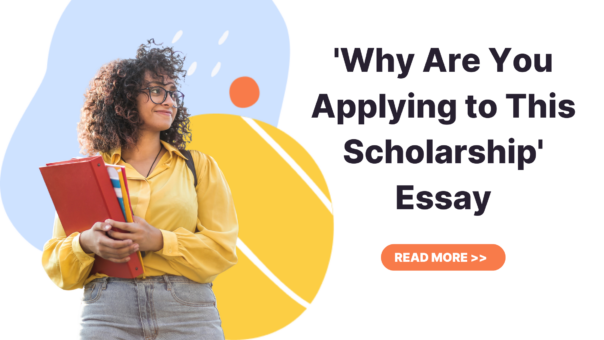
Why Are You Applying to This Scholarship Essay (with Example)

Common CSS Profile Questions
Get started with scholarshipowl.
Simplify and focus your application process with the one-stop platform for vetted scholarships
- Search All Scholarships
- Exclusive Scholarships
- Easy Scholarships to Apply For
- No Essay Scholarships
- Scholarships for HS Juniors
- Scholarships for HS Seniors
- Scholarships for College Students
- Scholarships for Grad Students
- Scholarships for Women
- Scholarships for Black Students
- Scholarships
- Student Loans
- College Admissions
- Financial Aid
- Scholarship Winners
- Scholarship Providers
Student-centric advice and objective recommendations
Higher education has never been more confusing or expensive. Our goal is to help you navigate the very big decisions related to higher ed with objective information and expert advice. Each piece of content on the site is original, based on extensive research, and reviewed by multiple editors, including a subject matter expert. This ensures that all of our content is up-to-date, useful, accurate, and thorough.
Our reviews and recommendations are based on extensive research, testing, and feedback. We may receive commission from links on our website, but that doesn’t affect our editors’ opinions. Our marketing partners don’t review, approve or endorse our editorial content. It’s accurate to the best of our knowledge when posted. You can find a complete list of our partners here .
How to Write a Scholarship Cover Letter

Gabriel Jimenez-Ekman is a content editor and writer at Scholarships360. He has managed communications and written content for a diverse array of organizations, including a farmer’s market, a concert venue, a student farm, an environmental NGO, and a PR agency. Gabriel graduated from Kenyon College with a degree in sociology.
Learn about our editorial policies

Maria Geiger is Director of Content at Scholarships360. She is a former online educational technology instructor and adjunct writing instructor. In addition to education reform, Maria’s interests include viewpoint diversity, blended/flipped learning, digital communication, and integrating media/web tools into the curriculum to better facilitate student engagement. Maria earned both a B.A. and an M.A. in English Literature from Monmouth University, an M. Ed. in Education from Monmouth University, and a Virtual Online Teaching Certificate (VOLT) from the University of Pennsylvania.
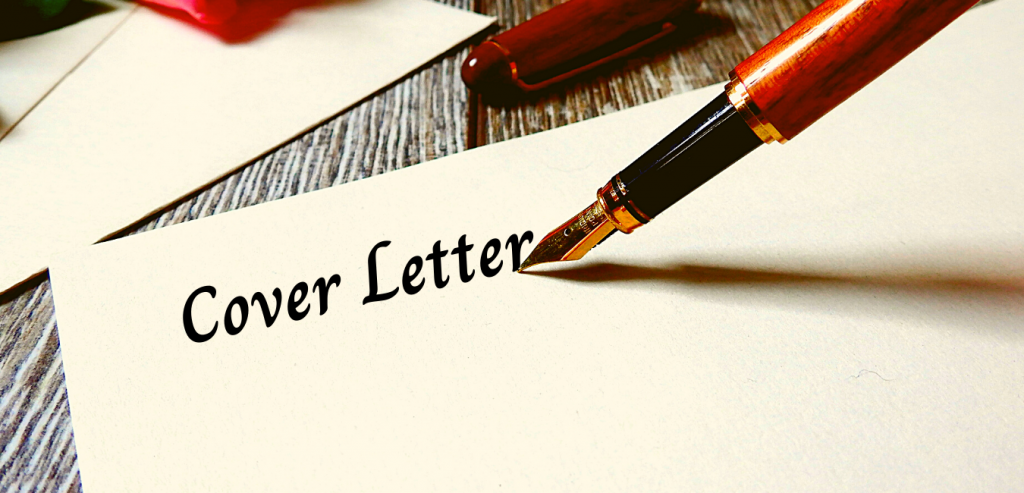
Scholarship cover letters might seem intimidating, but they should not deter you from applying for scholarships. Sometimes, students are intimidated because they don’t know how to write a scholarship cover letter. The following guide includes a thorough description of what you should address in the letter and how to format it.
First, let’s talk about the most fundamental question: what’s the ultimate goal of the cover letter?
Goals of a scholarship cover letter
Create a personal appeal by letting your voice come through.
Most scholarship applications largely consist of forms and checklists, but cover letters are a great opportunity for the reader to hear you make your case in your own voice. While you should still maintain a formal tone, you should not be afraid to write personably.
Emphasize the importance of your accomplishments
Resumes and application forms are great opportunities to describe your duties at past positions you’ve held, but a cover letter is a great opportunity to go one step further.
Describe the skills developed in your past positions
Think about how past learning experiences helped shape your ambitions. For example, if you had an internship in the office of a local government official, you could use your cover letter to describe how your experiences helped hone your organizational skills and shape your sense of civic duty.
- Share what you hope to pursue and build upon
How will you work towards your future goals and build upon your past experiences? Scholarship readers want to award their funds to students with a strong sense of ambition and an exciting future. Emphasize that you have big plans for the future, and how you will use the scholarship to accomplish them.
Highlight circumstances not addressed in the scholarship application
For example, if you have community service experience, but there was not a question in the application that allowed you to mention that, a cover letter is a great place to bring it up. This may not be specifically relevant to the scholarship, but speaks to your character and can help put you ahead of the crowd.
Start your scholarship search
- Vetted scholarships custom-matched to your profile
- Access exclusive scholarships only available to Scholarships360 members
Differences between a scholarship cover letter and a scholarship essay
Scholarship essays and cover letters have a lot in common:
- They are both opportunities to write about your future ambitions and show how you have reflected on your past experiences.
- Both allow you to make a personal appeal to your reader, and to bring up relevant information that was left out of the rest of the application.
However, while there is a lot of overlap between scholarship cover letters and scholarship essays, there are a few key differences:
- Scholarship essays are written in response to a prompt, but scholarship cover letters do not have an explicit prompt. For students who are used to prompts, this can be a stumbling block.
- One way to help overcome this open-endedness is to imagine the prompt as: “ Tell me about yourself and why you would be a good fit for this scholarship. ” Remember, the goal of a scholarship cover letter is to introduce yourself and to make a compelling case for your candidacy while highlighting assets not showcased in the rest of your application.
- Another key difference is in formatting; there are specific formatting rules for a scholarship cover letter, which we will cover below.
See also: How to write a winning scholarship essay
Formatting tips
While everyone’s cover letter is different and some scholarships may have specific requirements, here are a few general formatting tips to make your cover letter a success:
- Cover letters should be 1 page long, and it can be beneficial to break them down into small paragraphs to help the reader digest them more easily.
- They should also include a header with the date, your name and address, as well as your email and/or phone number.
- After the header, skip a line, and write the date.
- Skip another line, and include the name and title of the person you are addressing the letter to, and the address of the organization if available.
Some scholarships will list the name that the letter should be addressed. If you can’t find the name easily, try doing a bit of research to see if you can find the name of the person who will be reading your application. This can help put you ahead of your competition by showing that you did some additional research.
If you can’t find a name, you can skip that part of the header and write: “Dear selection committee” in your introduction. Here is an example header for someone who was able to find the name of their application reader:
James Wright 580 Chase Ln New Meadows, ID 83654 [email protected]
March 12, 2021
Ms. Carol Smith Better Business Bureau 12639 W Explorer Dr Boise, ID 83713
Dear Ms. Smith,
I am writing… ____________________________________________________________
Good luck writing your scholarship cover letter! Be sure to apply to all the scholarships you qualify for. Remember, there are scholarships for all demographics, including for women , high school seniors , and Black students. Some scholarships require essays and applications, but others are no-essay or easy to apply for scholarships . Remember, Scholarships360 is here to provide valuable resources and access to scholarships for students!
Key Takeaways
- Create personal appeal by letting your unique voice come through
- Emphasize the importance of your accomplishments and describe the skills learned in your past positions
- Highlight circumstances not addressed in your scholarship application
- Be mindful of any specific requirements when crafting your cover letter
Scholarships360 Recommended

Top 64 No Essay Scholarships in May 2024

Top 256 Scholarships for High School Juniors in May 2024

$20k+ in Exclusive Scholarships from Scholarships360
Trending now.


Top 55 Easy Scholarships✅ to Apply For in May 2024

Top 1,324 Scholarships for High School Seniors in May 2024

Top Scholarships for Current College Students in May 2024
3 reasons to join scholarships360.
- Automatic entry to our $10,000 No-Essay Scholarship
- Personalized matching to thousands of vetted scholarships
- Quick apply for scholarships exclusive to our platform
By the way...Scholarships360 is 100% free!

- 12 Scholarship Application Letter Samples (PDF, DOC)
Published: 03 May 2024 Scholarship Application 1,107 views
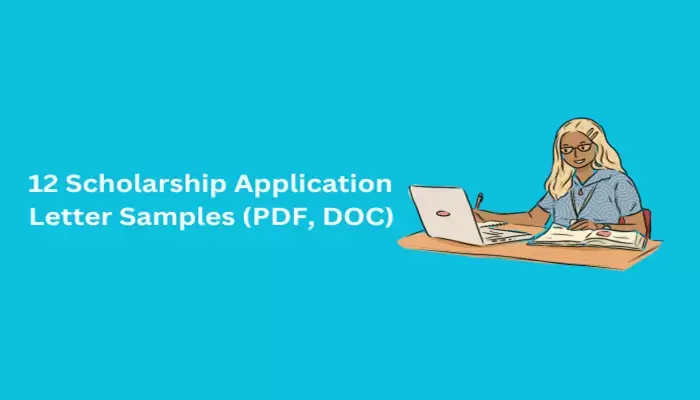
A scholarship application letter is a formal letter written by a student to an organization that provides financial assistance to support a student's education. Scholarships are available to students of all levels of education, from high school to postgraduate level.
If you're a student, applying for scholarships is one of the best ways to fund your education and a well written scholarship application letter is required to help you get one.
In a scholarship application letter, you will be expected to provide useful information about your accomplishments as a student and why you think you're a deserving candidate.
Before you start drafting your scholarship letter, review the requirements for the scholarship. This will help you have a better understanding of the ideal candidate the scholarship committee requires. You'll also know the credentials and information to include in your letter.
In this guide, we will discuss how to write a good scholarship application letter, a good application letter format and also provide 12 scholarship letter templates for you to download in pdf format.
What is a Scholarship Application Letter?
A Scholarship Application Letter is a formal letter a student writes to a scholarship committee to persuade them to be considered for a scholarship opportunity.
In a scholarship application letter, students are required to highlight their academic achievements as well as relevant skills and experiences that may not be outlined in their resume.
How to Write a Scholarship Application Letter?
Writing a scholarship application letter requires thorough understanding of the steps to write a good application.
If you want to learn how to write the best scholarship application letter that will guarantee a positive response from the scholarship review community, follow the steps below;
Always start your scholarship application letter with a professional salutation.
Keep your letter short, a good scholarship letter typically ranging from 300 to 500 words.
Ensure you give a clear reason for applying for the scholarship.
Always introduce yourself properly
Write about your relevant academic achievements, work experience, extracurricular activities, and any skills you may have.
Explain why you need the scholarship and how it will help you achieve your academic and career goals.
Write about your long term goals and close your letter with a strong conclusion summarizing key points in the letter.
Proofread your letter before submitting. You can give your letter to a friend to proofread for you- good scholarship application letters do not have typos or grammatical errors.
Always thank the scholarship committee for taking their time to read your letter and consider you for the scholarship.
Follow the correct scholarship letter format
Application for Scholarship Format
To write a good scholarship application letter, you have to be familiar with its structure.
Following the right scholarship format will help you compose your letter in a better way. A scholarship application letter has six major components which includes; the header, the salutation, introduction, the body, the conclusion and the closing.
The body of the letter contains the most important details required by the scholarship committee and it is usually divided into 2 or 3 paragraphs.
Here, we'll discuss the different components of a scholarship application letter. Keep reading to find out more.
Header: The header is the first part of a scholarship application letter located at the top of the letter. It should include your complete contact information such as your name, address, phone number, and email address.
You can also include the title of the letter typed in a bold font.
Salutation: Next is a professional salutation to begin the scholarship application letter. Examples of salutations you may use include; "Dear Scholarship Committee" “Respected Sir/Ma” or "To Whom It May Concern."
Introduction: After the salutation is the introductory paragraph. This is the official first paragraph of the letter where the scholarship applicant is expected to briefly introduce themselves and state the purpose of the letter.
The introduction can be written in three to five concise sentences.
An important tip to keep in mind when writing your introduction is to keep things as straight to the point as possible.
Body: the body of a scholarship application letter is where the main content lies. In the body of the letter, you'll provide details about your academic achievements, extracurricular activities, and any relevant experiences that will convince the scholarship committee to grant you the scholarship.
As we discussed earlier, the body of a scholarship application letter can be divided into 3 paragraphs. Let's discuss each of the paragraphs.
First Paragraph: in the first paragraph, write about your academic achievement and record. You can outline all the degrees you have gotten and their grades, you can also highlight your future plans for your academics.
Second Paragraph: The second paragraph details your work experience and extracurricular activities that may be relevant to the scholarship.
Third Paragraph: In the third paragraph, you can go a little further to explain how the scholarship will help you achieve your academic goals and why you deserve the scholarship.
Conclusion: The conclusion should be a strong statement summarising why you are a good fit for the scholarship. It should highlight key points you have made in the previous paragraphs and should fit into 2 or 3 sentences.
Lastly, thank the scholarship committee for their time and consideration in one sentence.
Closing: Always end your Scholarship Application Letter with a simple closing remark, like "Yours Sincerely" or "Kind Regards.”
It is important to keep your closing as professional as possible. The scholarship application letter is a formal letter so you want to avoid using any form of informal or casual remark or language.
Scholarship Application Letter Writing Format
A good scholarship application letter is required to follow a simple letter format that is easy to read and understand by the scholarship provider.
Here, we'll share a simple format for your scholarship application letter.
Always use a professional font like Times New Roman, Calibri or Arial
Use a font size between 10 and 12 points.
Your margins should be 1 inch on all sides, this makes your work easy to read.
Use single-spacing within paragraphs and double-spacing between paragraphs.
Avoid using a casual or informal tone in your Scholarship Application Letter.Also avoid the use of slangs or cliche words.
The scholarship application letter should have a formal tone.
Always include your name and contact information at the top of the scholarship application letter and introduce yourself in the first paragraph
Ensure you address the letter to the appropriate person or committee. Of you do not know who to address it to, use a generic term like ‘ Dear Sir/Ma’ or ‘Dear Scholarship Committee’
Scholarship Letter Template
Here are 12 scholarship letter template for you.
Application for Fellowship Sample Letter
Fellowship Sample Letter for download
Application Letter for Government Scholarship
Government Scholarship Sample Letter for download
Application Letter for Grant Scholarship
Grant Scholarship Sample Letter for download
Application Letter for Masters Scholarship
Masters scholarship sample letter for download, application letter for nursing scholarship , nursing scholarship sample letter for download, application letter for phd scholarship .
PhD Scholarship Sample Letter for download
Application Letter for Undergraduate Scholarship
Undergraduate Scholarship Sample Letter for download
Application Letter for Scholarship Grant
Scholarship Grant Sample Letter for download
Application Letter for Scholarship to Mayor
Scholarship to Mayor Sample Letter for download
Application Letter for Scholarship in University
Scholarship in University Sample Letter for download
Application Letter for Scholarship for Poor Students
Scholarship for Poor Students Sample Letter for download
Application for Scholarship to Principal
Scholarship to Principal Sample Letter for download
Application for Merit Scholarship Sample
Merit Scholarship Sample Letter for download
Do’s and Don'ts your Scholarship Application Letter
Here are some do's and don'ts to guide you as you draft your scholarship application letter.
Do not use the same application letter for every scholarship application
Do not paraphrase your CV
Do not quote others in your letter
Do not write about your flaws or deficiencies
Do not use slangs or informal language
Do not wait until last minute to submit your application letter
Do keep a positive tone
Do be concise
Do be honest
Do avoid typos or grammatical blunders
Do proofread
Do proper research before drafting your letter
Do highlight your accomplishments
With these scholarship application letter templates, you stand a chance at getting that scholarship you've always wanted. Download a template today and edit it the way you like.
Latest Scholarship Tips
- IT Schools In Lagos
- 20 Best Courses to Study in Nigeria 2024
- Federal Government student loan qualification, application and repayment
- How to Print JAMB Examination Slip 2024
- List Of NYSC Orientation Camps In Nigeria
- List Of Bauchi State Scholarship Accredited Centers And Their Locations 2024
- Canada Work Permit Visa Fees in Nigeria 2024
- Moniepoint Account Opening – How to Open Moniepoint Account
- How much is Canada Visa Fee in Nigeria 2024
- Universities offering law in Nigeria
Top Scholarships
- 2024 PTDF Scholarship Scheme for Undergraduate & Postgraduate Scholars in Nigeria Federal Universities
- 2024 Rehoboth Dream Solid Foundation Sponsorship Scholarship For Nigerian Undergraduate Students
- 2024-2025 Kwame Nkrumah University Of Science & Technology (KNUST) MasterCard Foundation Undergraduate Scholarships For African Students
- University Of Sheffield 2024 Masters Scholarship for African Students (Fully-funded)
- Western Union Foundation Fellowship Program 2024
- 2024 University Of Edinburgh Global Online Learning Masters Scholarship for Developing Countries
- 2025 Next Emerging Global Leader Scholar Award For International Students By American University
- 2024 ESISMAD Project African Scholarship for African Students (Fully-funded)
- MTN Foundation 2024 Scholarship Program for Nigerian Students
- 2024 UN Human Rights Commission Fellowship Program for People of African Descent (Switzerland)
Scholarship Tips
- Scholarships by Category
- Postgraduate
- Undergraduate
- College School
- Research Grant
- Entrepreneurs
- Graduate Programme
- Scholarships by Country
- United Kingdom
- United States
- South Africa
- Switzerland
Special Fundings
- Women Scholarships
- Study Abroad
- Partially Funded
- Fully Funded
- Innovation Network
- Innovation Exchange
- Innovation Awards
- Innovation Fellowships
- Innovation Funding
- Innovation Challenge
- Innovation Programme
- Government grants
- Scholarships by School
- University of Edinburgh
- University of Pretoria
- University of Ghana
- Oxford University
- University of Cambridge
- Harvard University
- University of London
- University of Cape Town
- Swansea University
- University of Bristol
- Scholarships by Sponsor
- Mastercard Foundation
- German Academic Exchange Service (DAAD)
- United Nations
- MTN Foundation
- African Union
- One Young World
- Access Bank PLC
- Privacy Policy
- Terms of Use
Scholarship Categories
- Undergraduate Scholarships
- Masters Scholarships
- Postgraduate Scholarships
- PhD Scholarships
- Study Abrod Scholarships
- NGO Scholarships
- JAMB CBT Centers
Scholarships By
- Scholarships by Course
- Scholarships by State
- Scholarships Gender
Other Locations
- Study Abroad Scholarships
- Scholarships for African Students
- Scholarships in UK
- Scholarships in Canada
- Study Abroad Community
What are your chances of acceptance?
Calculate for all schools, your chance of acceptance.
Your chancing factors
Extracurriculars.
How to Write a Personal Statement for a Scholarship + Examples
What’s covered:, what is the purpose of the scholarship personal statement, what to include in your personal statement, personal statement example: breakdown + analysis, how to make sure your writing is effective.
Either before or after you’ve gotten into your dream school, you’ll have to figure out how to pay for it. For most students, this involves a combination of financial aid, parent contributions, self-contributions, student loans, and scholarships/grants. Because scholarships are money out of someone else’s pocket that you never have to pay back, they are a great place to start!
Scholarships come in two forms: merit-based and need-based. Need-based scholarships are also often called grants. These designations tell you whether an organization looks at your financial situation when deciding about your scholarship.
Additionally, different scholarships fall under different categories based on the mission of the organization or person providing the scholarship’s financing. These missions typically emphasize different things like academic achievement, specific career goals, community service, leadership, family background, skill in the arts, or having overcome hardship. As you select scholarships to apply for and complete your applications, you should keep these missions in mind.
No matter what type of scholarship you are applying for, you will be asked to provide the review committee with standard materials. This includes your transcript, GPA, and resume/extracurriculars, but also, importantly, your personal statement. A scholarship personal statement is a bit different from your normal college essay, so we’ve put together this guide and some examples to help you get started!
The purpose of your personal statement is to help a review committee learn more about your personality, values, goals, and what makes you special. Ultimately, like with your college essays, you are trying to humanize your profile beyond your transcript, GPA, and test scores.
College essays all have one goal in mind (which is why you can apply to multiple schools at once through applications like the Common App or Coalition App): convince admissions officers that you would be a valuable addition to the university environment. The goal of your scholarship personal statement is different and differs more from one scholarship to the next. Rather than convincing various review committees that you are a generally good candidate for extra funding for college, you need to convince each review committee that your values have historically aligned with their organization’s mission and will continue to align with their organization’s mission.
Common missions amongst those who give scholarships include:
- Providing opportunities for students with career ambitions in a particular field
- Helping students who have experienced unexpected hardship
- Supporting students who show outstanding academic achievement
- Funding the arts through investing in young artists with strong technical skill
- Supporting the development of civic-minded community service leaders of the future
- Providing opportunities for historically underrepresented ethnic communities
If a specific mission like this is outlined on an organization’s website or in the promotional material for its scholarship, the purpose of your personal statement is to show how you exemplify that mission.
Some scholarships ask for your personal statement to be guided by a prompt, while others leave things open for interpretation. When you are provided a prompt, it is obvious what you must do: answer the prompt. When you are not provided a prompt, you want to write a personal statement that is essentially a small-scale autobiography where you position yourself as a good investment. In either case, you should identify a focus or theme for what you are trying to say about yourself so that your application does not get lost in the shuffle.
Prompts include questions like:
- Why do you deserve this scholarship?
- How have you shown your commitment to (leadership/community service/diversity) in your community?
- When did you overcome adversity?
- Why is attending college important to you?
If you are provided a prompt, develop a theme for your response that showcases both your values and your achievements. This will help your essay feel focused and will subsequently help the review committee to remember which candidate you were as they deliberate.
Themes include things like:
- I deserve this community service scholarship because my compassion for intergenerational trauma has inspired me to volunteer with a local after-school program. I didn’t just sympathize. I did something about my sympathy because that’s the type of person I am. Within the program, I have identified avenues for improvement and worked alongside full-time staff to develop new strategies for increasing attendance.
- I overcame adversity when my mother had to have a major surgery two months after giving birth to my younger brother. I was just a kid but was thrown into a situation where I had to raise another kid. It was hard, but I’m the kind of person who tries to grow from hard times and, through my experience taking care of a baby, I learned the importance of listening to body language and nonverbal cues to understand the needs of others (baby and nonbaby, alike).
Without a prompt, clarity can be harder to achieve. That said, it is of the utmost importance that you find a focus. First, think about both your goals and your values.
Types of goals include:
- Career goals
- Goals for personal growth
- The type of friend you want to be
- The change you want to make in the world
Values could include:
- Authenticity
- And many more!
After you write out your goals/values, write out your achievements to see what goals/values you have “proof” of your commitment to. Your essay will ultimately be an exploration of your goal/value, what you have done about your goal/value in the past, and what you aspire to in the future.
You might be tempted to reflect on areas for improvement, but scholarships care about you living out your values. It is not enough to aspire to be exemplary in leadership, community service, or your academic field. For scholarships, you have to already be exemplary.
Finally, keep in mind that the review committee likely already has a copy of your extracurricular activities and involvement. Pick one or two accomplishments, then strive for depth, not breadth as you explore them.
My interest in the field of neuroscience began at a young age. When I was twelve years old, my sister developed a condition called Pseudotumor Cerebri following multiple concussions during a basketball game. It took the doctors over six months to make a proper diagnosis, followed by three years of treatment before she recovered. During this time, my love for neuroscience was sparked as I began to research her condition and, then, other neurocognitive conditions. Later, my love of neuroscience was amplified when my mother began to suffer from brain-related health issues. My mother had been a practicing attorney in Dallas for over twenty years. She was a determined litigator who relentlessly tried difficult cases that changed people’s lives. Now, she suffers from a cognitive impairment and is no longer able to practice law. Oftentimes, she has headaches, she gets “cloudy,” her executive functioning slows down, she feels overwhelmed, and she forgets things. My mother has gone from being the strong, confident, emotional and financial caretaker of our family to needing significant help on a daily basis. Once again, with this illness came a lot of research on my part — research that encouraged me to pursue my dreams of exploring neuroscience.
Due to my experiences with my mother and sister when I was in middle school, I knew that I wanted to make a difference in the field of neuroscience. I also knew that, to obtain this goal, I needed to maintain superior grades in school while also pursuing opportunities outside of school to further my education. In school, I was able to maintain superior grades to the point where I am currently valedictorian in a class of 567 students. In addition, in school, I challenged myself by taking 16 Advanced Placement classes and 19 Honors classes. Two of the most beneficial classes were AP Capstone Seminar and AP Capstone Research. AP Capstone Seminar and AP Capstone Research are research-oriented classes where students are given the opportunity to pursue whatever track their research takes them down. As a junior in AP Capstone Seminar, I researched the effects of harmful pesticide use on the prevalence of Autism Spectrum Disorder (ASD) in children. This year, as a senior in AP Capstone Research, I am learning about the effects of medical marijuana on the treatment of Multiple Sclerosis (MS).
Outside of school, I furthered my education through taking advantage of the Duke TiP summer program. Duke TiP is a summer program run by Duke University where students who score extremely well on the SAT as middle schoolers are able to take college classes at different universities throughout the summers of their middle school and high school years. I took advantage of this opportunity twice. First, I went to Trinity University in San Antonio to expand my horizons and learn more about debate. However, once I was done exploring, I decided I wanted to go into neuroscience. This led me to take an Abnormal Psychology class at Duke University’s West Campus. This class opened my eyes to the interaction between neuroscience and mental health, mental illness, and personality. Years later, I am currently continuing my education outside of school as an intern at the University of Texas Dallas Center for Brain Health. Through this internship, I have been able to see different aspects of neuroscience including brain pattern testing, virtual reality therapy, and longitudinal research studies. With this background, I have positioned myself to be accepted by top neuroscience programs throughout the nation. So far, I have been accepted to the neuroscience department of University of Southern California, the University of Virginia, the University of Texas, and Southern Methodist University, as well as the chemistry department at University of North Carolina–Chapel Hill.
It is with this passion for neuroscience driven by my family and passion for education driven by internal motivation that I will set out to conquer my career objectives. My educational aspirations consist of acquiring a bachelor’s degree in a biological or health science that would assist me in pursuing a medical career as a neuroscience researcher. I decided to attain a career as a researcher since my passion has always been assisting others and trying to improve their quality of life. After obtaining my Masters and my PhD, I plan to become a professor at a prestigious university and continue performing lab research on cognitive disorders. I am particularly interested in disorders such as Autism Spectrum Disorder (ASD). In the lab, I hope to find different therapies and medications to help treat the 3.5 million people around the world suffering from ASD. Furthermore, I want to contribute back to underserved populations that struggle because they do not have as much access to medical assistance as other privileged groups. As such, I hope to do a part of my research in less developed or developing Spanish-speaking countries. This will also allow me to pursue my love of Spanish while pursuing my love of neuroscience. I think that following such a career path will provide me the opportunity to learn about the medical needs of the autistic community and improve their quality of health. Furthermore, I hope to train a new generation of students to strive to research and make comparable discoveries. Whether it be through virtual reality labs or new drug discoveries, I believe that research leads to innovation which leads to a brighter future.
This student does a great job of making themself appear competent and dedicated to the field of neuroscience. This is primarily because they provided tangible evidence of how they have pursued their dedication in the past—through their AP Capstone courses, their Abnormal Psychology class at Duke TiP, and their internship at UTD. There is no doubt in the mind of a reader that this student is high-achieving.
This student also engages successfully with a past-future trajectory, where they end with a vision of how they will continue to use neuroscience in the future. This helps the review committee see what they are investing in and the ways that their money will go to good use.
This student has two major areas for improvement. As we have said, the purpose of a personal statement is for a student to humanize themself to a review committee. This student struggles to depict themself separately from their academic achievements. A solution to this would be for the student to establish a theme towards the beginning of their essay that relates to both their values as a human and their achievements.
At the beginning of the essay, the student explores how their interest in neuroscience began. They explain their interest through the following sentences: “During this time, my love for neuroscience was sparked as I began to research her condition and, then, other neurocognitive conditions” and “Once again, with this illness came a lot of research on my part — research that encouraged me to pursue my dreams of exploring neuroscience.” The student made the great decision to tell the backstory of their interest, but they described their research in very mundane and redundant terms. Instead, they could have focused on their value of intellectual curiosity as a magnetic force that encouraged them to research their mother and sister’s ailments. Curiosity, then, could serve as a value-related thematic throughline to taking AP Capstone classes, taking college courses during the summer that weren’t required, and interning before even graduating high school.
A second area for improvement would be avoiding statistics. As the student identifies their valedictorian status and the number of AP classes they have taken, they might turn away certain personalities on a review committee by appearing braggy. Even further, these statistics are a waste of space. The review committee already has access to this information. These words distract from the major theme of the essay and would have been better used to humanize the student.
Throughout my academic career, I have been an avid scholar, constantly pushing myself towards ambitious goals. I held and continue to hold myself to a high standard, enrolling myself in rigorous curriculum, including Honors and Advanced Placement courses to stretch my mental potential. During my junior year of high school, I took four AP tests, two on the same day, and earned the AP Scholar with Honor Award. Additionally, I received the Letter of Commendation for the PSAT/NMSQT, and qualified for Rotary Top 100 Students both my freshman and senior year, a sign of my commitment to my studies. However, school has not been all about having the best GPA for me; beyond the numbers, I have a deep drive to learn which motivates me to do well academically. I truly enjoy learning new things, whether it be a new essay style or a math theorem. I always give each class my best effort and try my hardest on every assignment. My teachers have noticed this as well, and I have received school Lancer Awards and Student of the Month recognitions as a result. It is a major goal of mine to continue to aspire towards a high level of achievement regarding future educational and occupational endeavors; I plan on continuing this level of dedication throughout my educational career and implementing the skills I have learned and will learn into my college experience and beyond.
This fall, I will begin attending the University of California Los Angeles as an English major. I chose this major because I am fascinated by written language, especially its ability to convey powerful messages and emotions. I also enjoy delving into the works of other authors to analyze specific components of their writing to discover the meaning behind their words. In particular, I cannot wait to begin in-depth literary criticism and learn new stylistic techniques to add more depth to my writing. Furthermore, I recently went to UCLA’s Bruin Day, an event for incoming freshmen, where I was exposed to many different extracurriculars, some of which really piqued my interest. I plan on joining the Writing Success Program, where I can help students receive free writing help, and Mock Trial, where I can debate issues with peers in front of a real judge. The latter, combined with a strong writing background from my undergraduate English studies will be extremely beneficial because I plan to apply to law school after my undergraduate degree. As of now, my career goal is to become a civil rights lawyer, to stand up for those who are discriminated against and protect minority groups to proliferate equality.
As a lawyer, I wish to utilize legislation to ameliorate the plight of the millions of Americans who feel prejudice and help them receive equity in the workplace, society, and so on. Though this seems a daunting task, I feel that my work ethic and past experience will give me the jumpstart I need to establish myself as a successful lawyer and give a voice to those who are often unheard in today’s legal system. I have been a Girl Scout for over a decade and continually participate in community service for the homeless, elderly, veterans, and more. My most recent project was the Gold Award, which I conducted in the Fullerton School District. I facilitated over ten workshops where junior high students taught elementary pupils STEM principles such as density and aerodynamics via creative activities like building aluminum boats and paper airplanes. I also work at Kumon, a tutoring center, where I teach students to advance their academic success. I love my job, and helping students from local schools reach their potential fills me with much pride.
Both being a Girl Scout and working at Kumon have inspired me to help those in need, contributing significantly to my desire to become a lawyer and aid others. My extracurriculars have allowed me to gain a new perspective on both learning and teaching, and have solidified my will to help the less fortunate. In college, I hope to continue to gain knowledge and further develop my leadership skills, amassing qualities that will help me assist others. I plan to join multiple community service clubs, such as UCLA’s local outreach programs that directly aid residents of Los Angeles. I want to help my fellow pupils as well, and plan on volunteering at peer tutoring and peer editing programs on campus. After college, during my career, I want to use legal tactics to assist the underdog and take a chance on those who are often overlooked for opportunities. I wish to represent those that are scared to seek out help or cannot afford it. Rather than battling conflict with additional conflict, I want to implement peaceful but strong, efficient tactics that will help make my state, country, and eventually the world more welcoming to people of all ethnic and socioeconomic backgrounds. These goals are close to my heart and therefore I will be as diligent as I am passionate about them. My perseverance and love for learning and community service drive my ambition in both education and life as a whole, and the drive to make the world a better place is one that I will carry with me for my entire life.
This student emphasizes two values in this essay: hard work and community service. These are values that go together nicely, and definitely make sense with this student’s end goal of becoming a civil rights lawyer! That said, some changes could be made to the way the student presents their values that would make their personal statement more convincing and engaging.
Structurally, instead of using a past-future trajectory, this student starts by explaining their academic achievements, then explains their career goals, then explains their history of community service, then explains their future desires for community service. This structure loses the reader. Instead, the student should have started with either the past or the future.
This could look like 1) identifying their career goals, 2) explaining that hard work and a commitment to community service are necessary to get there, and 3) explaining that they aren’t worried because of their past commitment to hard work and community service. Or it could look like 1) providing examples of their hard work and community service in the past, then 2) explaining how those values will help them achieve their career goals.
Additionally, like with our other example, this student shows a heavy investment in statistics and spouting off accomplishments. This can be unappealing. Unfortunately, even when the student recognizes that they are doing this, writing “beyond the numbers, I have a deep drive to learn which motivates me to do well academically. I truly enjoy learning new things, whether it be a new essay style or a math theorem,” they continue on to cite their achievements, writing “My teachers have noticed this as well, and I have received school Lancer Awards and Student of the Month recognitions as a result.” They say they are going beyond the numbers, but they don’t go beyond the awards. They don’t look inward. One way to fix this would be to make community service the theme around which the essay operates, supplementing with statistics in ways that advance the image of the student as dedicated to community service.
Finally, this student would be more successful if they varied their sentence structure. While a small-scale autobiography can be good, if organized, every sentence should not begin with ‘I.’ The essay still needs to be engaging or the review committee might stop reading.
Feedback is ultimately any writer’s best source of improvement! To get your personal statement edited for free, use our Peer Review Essay Tool . With this tool, other students can tell you if your scholarship essay is effective and help you improve your essay so that you can have the best chances of gaining those extra funds!
Related CollegeVine Blog Posts

- Grades 6-12
- School Leaders
Enter Today's Teacher Appreciation Giveaway!
10 Strong Scholarship Recommendation Letter Examples
Help make college more affordable for your students.
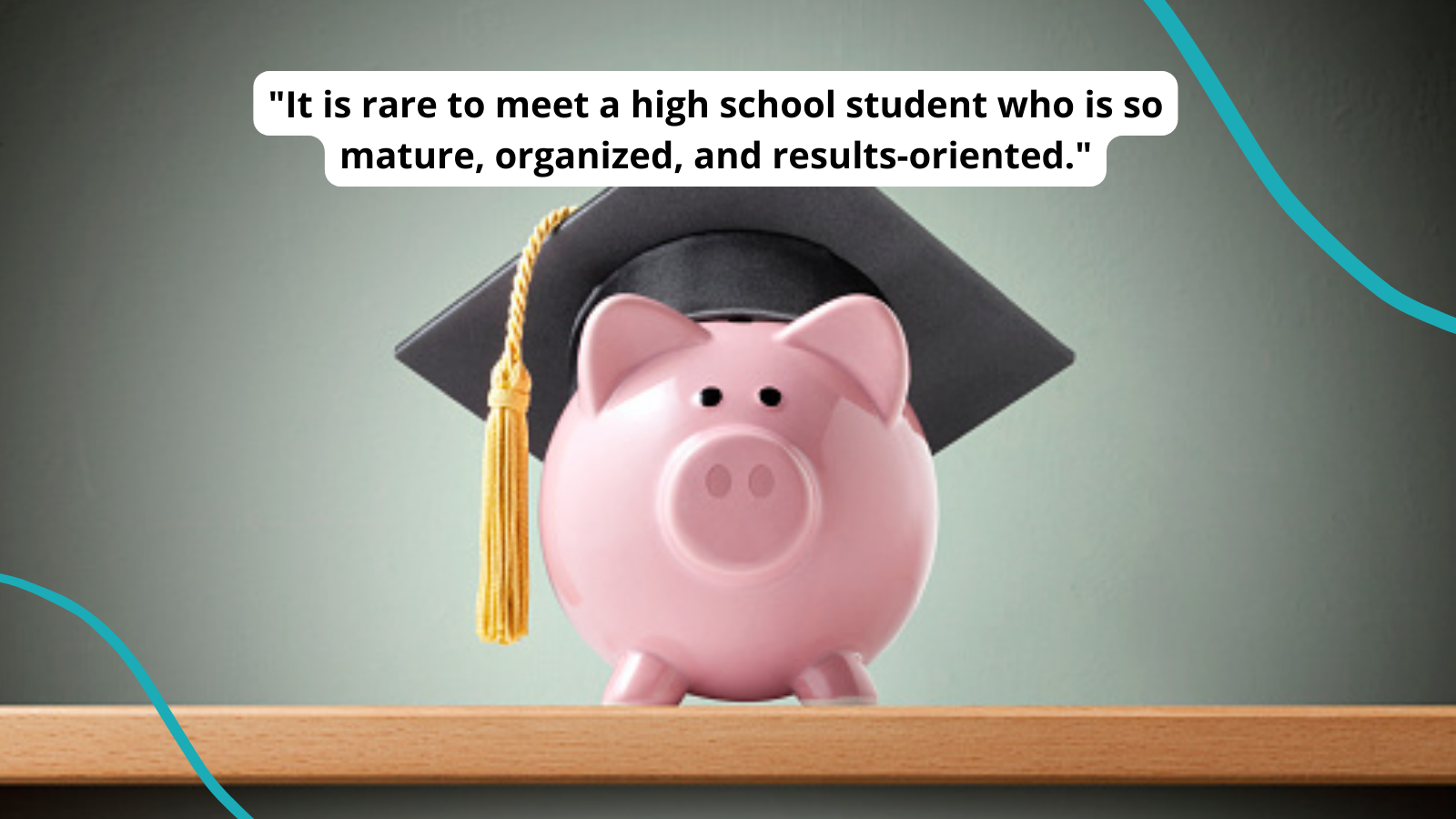
Paying for college takes a lot of planning. Tuition costs rise every year and graduates are buckling under the weight of debt from loans. For some, the expense of higher education is prohibitive, with many talented students being forced to cut their dreams short. Scholarships can make getting a degree more affordable. Students qualify based on academic performance, special interests, or financial needs. If you’ve been asked to help with the process, we’ve got you covered! Here’s a list of sample recommendation letters for scholarship applications that best meet your students’ needs.
How To Write Scholarship Recommendation Letters
If you’ve been asked to write a recommendation letter for your student’s scholarship, you might feel overwhelmed. You want to help your student, but you’re worried your letter won’t be good enough. In the end, you can only do your best, so lead with your heart and consider the following suggestions:
- Use letterhead and add your personal information (full name, title, school name, etc.) in the top left corner.
- Fill the whole page (at least 300 words) with an introduction, two or three paragraphs, and a conclusion.
- In the first paragraph, introduce your student, specify the scholarship for which they are applying, and share details about the nature and length of your relationship.
- In the body paragraphs, describe the ways your student is suitable and deserving of the scholarship.
- In your final section, pull everything together and emphasize your student’s strengths as well as the reasons why you are endorsing them.
Here’s a quick video on how to craft an effective scholarship recommendation letter:
Don’t feel you can honestly provide a positive recommendation? Gently decline their request for a letter. Avoid putting yourself in a position where you will have to be insincere. You don’t want to write something negative because it could cost the student an opportunity to earn a scholarship.
Sample Recommendation Letters for Scholarship Applications
1. general scholarship recommendation letter.
This is a great sample scholarship letter if you’re trying to offer a rounded view of a student’s performance in high school. You’ll include information about your experience with them as well as your thoughts on their potential success in a higher-education setting.
2. Sample Rhodes Scholarship letter
If your student is a candidate for a prestigious award such as the Rhodes Scholarship, this sample scholarship letter will give you an idea of what to share with the selection committee. With these types of recommendation letters, you want to provide as much praise and positive information as possible.
3. Scholarship letter for math students
There are many great scholarship opportunities for strong math students. This sample recommendation letter outlines how to share not only your student’s math talents but the other traits that make them a good candidate as well.
4. Leadership scholarship sample letter
This helpful scholarship recommendation letter offers an example for highlighting leadership skills. Back up your endorsement by sharing specific situations as well as participation in any committees, programs, and events where your student excelled.
5. Scholarship letter for international studies
Does your student plan to go abroad? If so, review this sample for writing a strong letter of recommendation for this specific type of scholarship. Be sure to include evidence as to why you believe your student is well rounded and exceptional.
6. Environmentalist scholarship letter
Has one of your students decided to pursue a degree in environmental sciences and wildlife? If so, this scholarship recommendation letter is a good example because it concisely highlights their strengths and shares why they would make a good candidate.
7. Scholarship letter for students who need financial assistance
No one should miss out on a college education because they can’t afford to pay. You can help them overcome this barrier! This excellent sample letter of recommendation shows the details to include for scholarships based on financial need.
8. Scholarship recommendation letter for STEM students
There are many scholarships for students who plan to pursue a career in STEM fields. If you’ve been asked to write a letter of recommendation for this type of scholarship, this sample will give you a good idea of what to include.
9. Greek society scholarship letter sample
Fraternities and sororities can be a great source of financial support for college and university students. Review this sample recommendation letter for scholarship applications for Greek society candidates.
10. Personal endorsement for scholarships
This sample recommendation letter for a scholarship application is best when you can’t vouch for the prospective student’s academic performance but want to share information about their personal character and how it relates to the scholarship program.
Do you have a great sample recommendation letter for scholarship applications? Please share it in the comments below!
Plus, check out the ultimate guide to college scholarships, want more articles like this be sure to subscribe to our newsletters ..
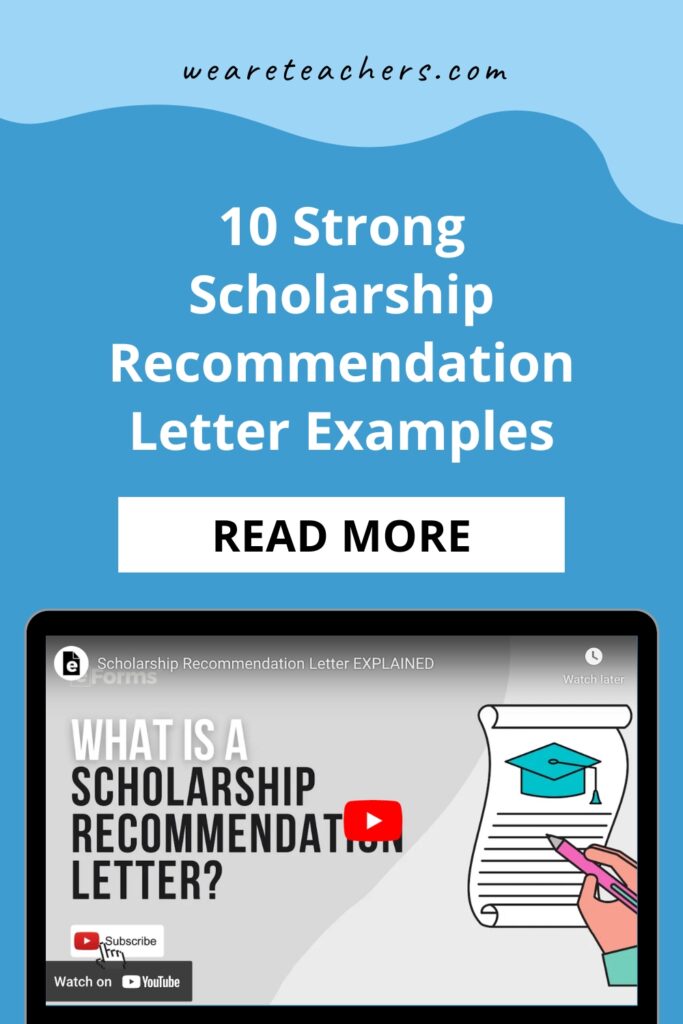
You Might Also Like
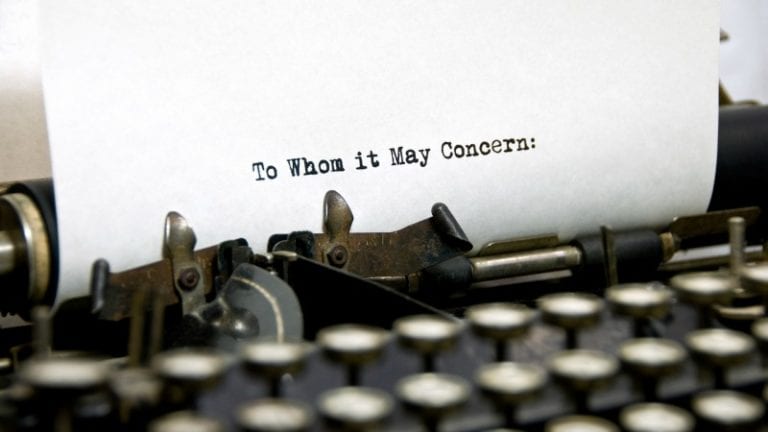
Tips for Writing a Genuine and Powerful College Recommendation Letter
Your words can make a big difference. Continue Reading
Copyright © 2024. All rights reserved. 5335 Gate Parkway, Jacksonville, FL 32256

High School Scholarship Application
Application generator.

Quality education comes with a great price, or so they say. The Center on Budget and Policy Priorities reports that between the years 2008-2018, in the efforts of adjusting to the inflation rate, universities in over 50 states in America increased their tuition fees by 37%. Schools and universities who claim to offer the best education have gotten more and more expensive, which further lessens the opportunities of students who belong to a low-income family to access it. Although the chances are less, it’s not impossible. Some prestigious high schools offer scholarships to give opportunities and aid to intelligent and talented students who have financial needs. For students who are interested in shooting their shot and being part of these schools, it would be a smart move to look for scholarship offers and submit a high school scholarship application form as early as now.
What Is a High School Scholarship Application Form?
A scholarship is a funding grant offered to deserving students to support their education. Scholarships are not for everyone; the scholarship-provider would only give the award to those who can meet their standards. Aside from the socioeconomic status of a student, another basis of this is one’s achievements and merits in diverse fields.
High school scholarships are one of the most common kinds of scholarships that are available today. A high school application form is a document that requires more than your name and signature. It needs plenty of other things such as letters and essays, which could help the school or the organization to scrutinize the applications and find the most deserving students for the slots. Once completed, this form is what you need to submit to apply for a high school scholarship.
Types of Scholarships
Scholarships are not only limit to the smartest or the most athletic students; there are plenty of other scholarships that are being offered by sponsors. Shared below are different youth scholarships for students of different specialties.
1. Academic Scholarships
This scholarship is considered to be one of the most esteemed scholarships that a person could receive. Academic scholarships are merit-based and are also usually given to students who participated in the most impressive extracurricular activities.
2. Creative Scholarships
Artistically talented students could opt for a creative scholarship. Art is a vast topic, wherein music, dancing, sculpting, and other art forms are a part of. Sponsors often organize an audition for this type of scholarship. If you are an artist , then you qualify for this type of scholarship.
3. Community Service Scholarships
If you are the type of student who loves to repay their communities through service, this scholarship is for you. Although this scholarship rewards you value that is smaller than other scholarships, attaining it is still as rewarding.
4. Scholarship for Minorities
People who belong to the minority or individual ethnic groups are qualified to apply for this type of scholarship. This scholarship is given to selected students for them to represent their culture and ethnicity.
5. Athletic Scholarships
This scholarship is offered to people with exceptional skills in sports . If you are an athletic type of person and you happen to be good at a particular sport, then pursue an athletic scholarship.
6. Unusual Scholarships
The name itself gives it away. A private company , an organization, or a particular person sponsors this type of scholarship. They give this scholarship for the most surprising and odd reasons.
7. Scholarships for Women
Women, in particular, are the beneficiaries of this scholarship. Being a woman isn’t the only qualification for this scholarship award; one should also have a strong determination to succeed.
High school scholarships have different qualifications. Start evaluating yourself now so you can determine which scholarship suits you. Once you find one, pursue it.
11+ High School Scholarship Application Form Examples
1. high school scholarship application form.
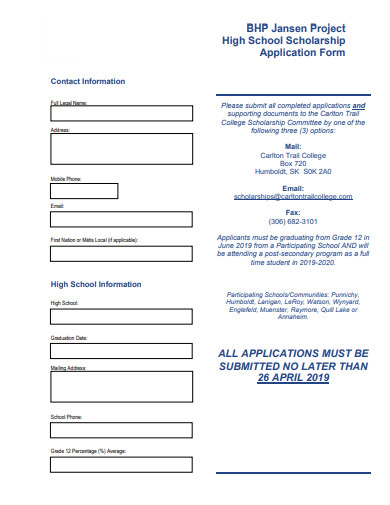
Size: 163 KB
2. High School Scholarship Application Example
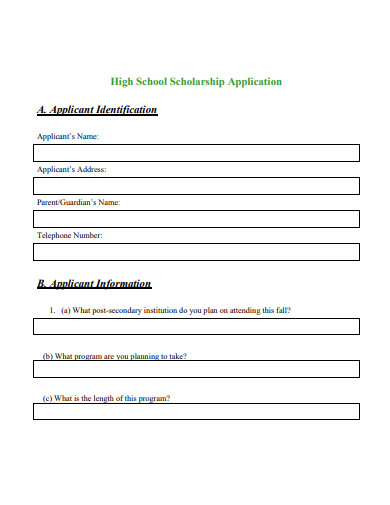
Size: 184 KB
3. Basic High School Scholarship Application

Size: 293 KB
4. High School Scholarship Application for Seniors
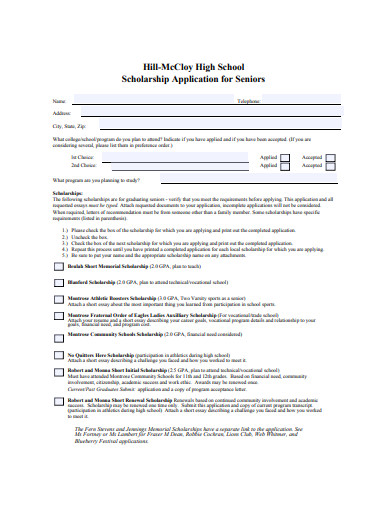
Size: 217 KB
5. High School Scholarship Application Format
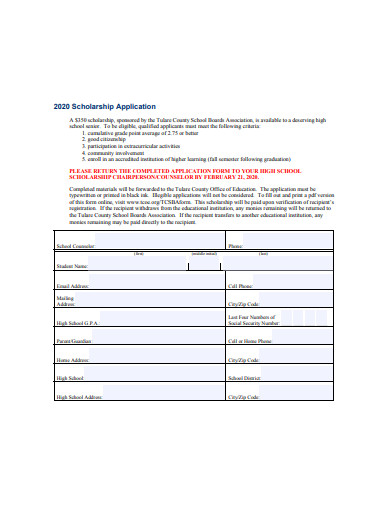
Size: 200 KB
6. Sample High School Scholarship Application
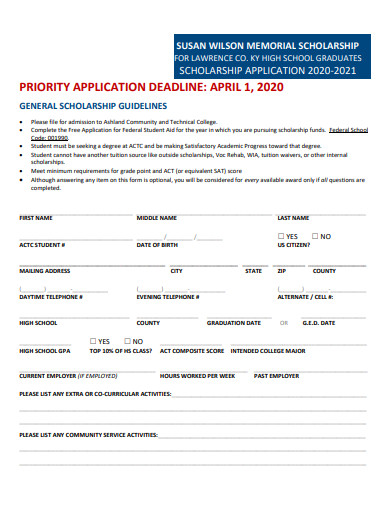
Size: 603 KB
7. 2019 High School Scholarship Application
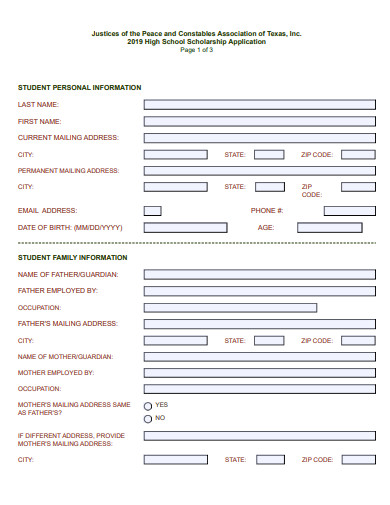
Size: 399 KB
8. Sample High School Scholarship Application Form
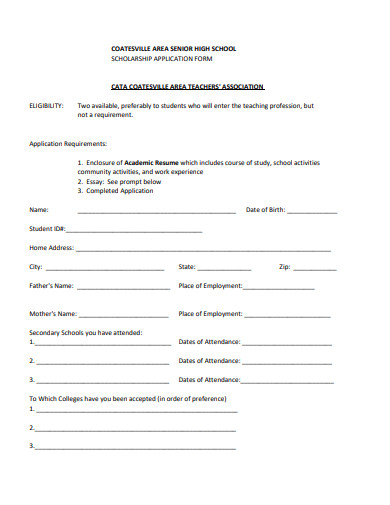
Size: 105 KB
9. Printable High School Scholarship Application Form
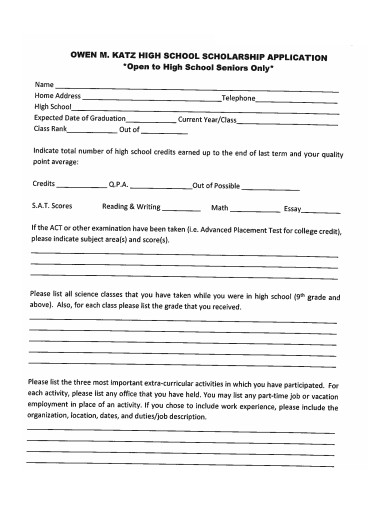
Size: 70 KB
10. Basic High School Scholarship Application Example
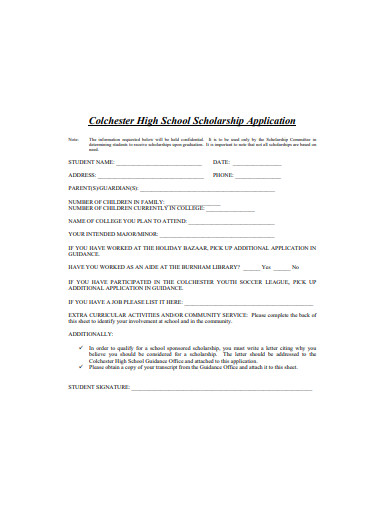
Size: 53 KB
11. High School Student Scholarship Application
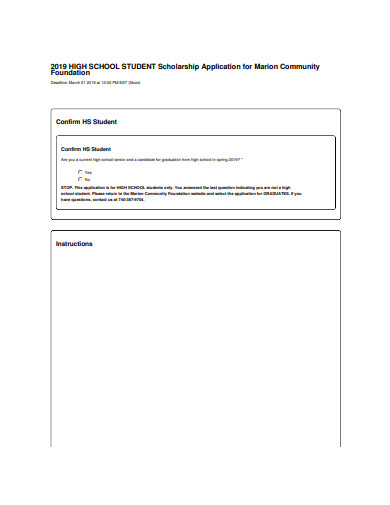
Size: 255 KB
12. High School Scholarship Application in DOC
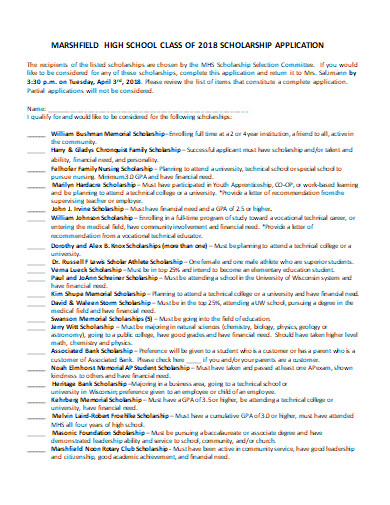
Size: 13 KB
How To Boost Your Chances of Getting a High School Scholarship
The more people submit application letters for a scholarship, the thinner your chances can get. Standing out from thousands of other high school scholarship applicants has been a major subject of worry for aspiring scholars. Here are some steps to increase your chances in attaining a scholarship:
1. Inquire Early
It’s never too early to look for high school scholarships. As early as possible, search and inquire for scholarships — ask your teachers and guidance counselor, browse through social media, visit school websites. Before your application, look up for the qualifications of the specific scholarship that you like best, and do your best to qualify for it. Do better in school , join a sorority with a good reputation, do community service, these are some things you could try out.
2. More Entries, More Chances of Winning
Keep this mantra in mind and apply it in looking for scholarships. Apply for multiple scholarships in different categories, that way you can increase the possibility of you bagging a sponsorship . If you are both athletic and an academic achiever, apply for academic scholarships and athletic scholarships at the same time.
3. Look Good with Letters of Recommendation
Letters of recommendation are essential attachments for a high school application form. This letter could help you look more appealing in the eyes of the analyst. Don’t be shy to ask your teacher or mentor to write you one. Prior to writing one, read the application form if there are specific instructions given regarding the recommendation letter .
4. Write an Impressive and Impactful Essay
Most high school scholarship application forms requires you to write a scholarship essay , and if it does, do not get intimidated by it. The essay is the most crucial part of your application form and consequently should be the best. It is important to remember that before you start writing your essay, you should read the instructions, there could be a word count or specific formatting required. Whether you write a generic essay or a unique one is up to you. Still, you should make sure that your essay shows off your writing skills and further convince the committee why out of all the other applicants, you are the most deserving of the scholarship.
5. Proofread Everything
You are up against plenty of other deserving applicants for this scholarship application, so make sure not to mess up. Go over everything and make sure that you have presented yourself in the best way possible. It is significant to check your application form for possible mistakes and make sure that you have followed all the instructions given. Submit your application on the given deadline. In the end, it wouldn’t matter how good your high school scholarship application is if you were not even able to follow simple instructions.
Scholarships could be your one-way ticket to the life that you dream of living, so make sure you have given your best in applying for it. You may not be born with a prosperous life, but you are always presented with opportunities to achieve it. Don’t miss out on opportunities and use them wisely. If you follow the steps that were shown above, you could undoubtedly expect a scholarship award letter in your mail.
Text prompt
- Instructive
- Professional
Create an application for a high school scholarship, focusing on academic achievements and extracurricular activities
Generate an application for a student council position, highlighting leadership qualities and ideas for school improvement
- Career & Salary Information
- Career Questions & Answers
- Career Videos

Lift Parts Express Scholarship

Scholarship Deadline: (Deadline Passed)
To be eligible for the Lift Parts Express Scholarship a student must:
1) A Current Senior in High School or 2) A Freshman or Sophomore in College/University. 3) Be a legal resident of the United States or Canada. 4) Enrolled or expected to be enrolled by the Fall of 2024. 5) Submit a completed online application form prior to the deadline.

10 Words or Less Scholarship

Summitt Physical Therapy Scholarship
How To Write Scholarship Application Letter (FREE Sample Templates)
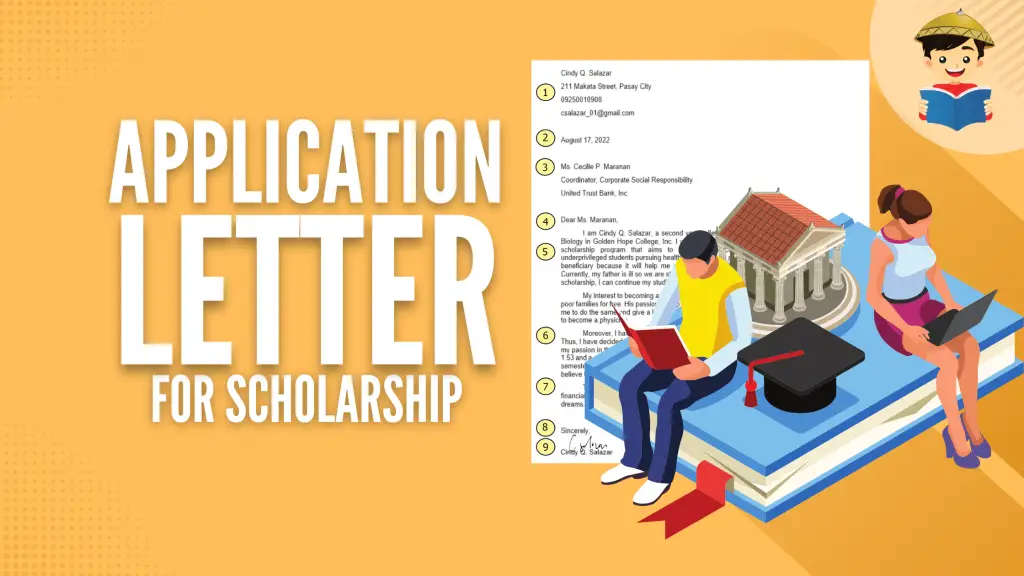
With limited slots and hundreds of aspiring applicants, grabbing a scholarship opportunity feels far from someone’s reach.
Through a scholarship application letter, you can increase your odds of getting the grant by standing out from other applicants.
Let this article guide you on how to write an impressive scholarship application letter.
Table of Contents
1. university-based scholarship application letter (for college students), 2. school-based scholarship application letter (for high school students), 3. government scholarship application letter, 4. private scholarship application letter, 5. scholarship application letter addressed to a public official (i.e., mayor, governor, congressman, etc.), 6. post-graduate scholarship application letter.
- 7. Foreign Scholarship Application Letter
What Is a Scholarship Application Letter?
What is the difference between a scholarship application letter and a letter of intent (loi) for a scholarship, what is the difference between a scholarship application letter and a scholarship essay, what does a scholarship application letter look like, 1. get to know the scholarship you’re applying for, 2. complete the letterhead and provide a short salutation, 3. introduce yourself and mention your desire and reason for applying, 4. convince the scholarship committee you deserve to get the scholarship using your academic achievements, extra-curricular activities, soft skills, etc., 5. highlight the significance of scholarship to your success and express your gratitude to the reader, 6. conclude your letter, tips and warnings, at a glance: scholarship application letter templates (free download).
Do you need to make a Scholarship Application Letter in haste? We’ve got you covered!
Select from the list of free downloadable and editable scholarship application letter templates below. Just click the corresponding link of your preferred template to automatically download the Microsoft Word file.
7. Foreign Scholarship Application Letter
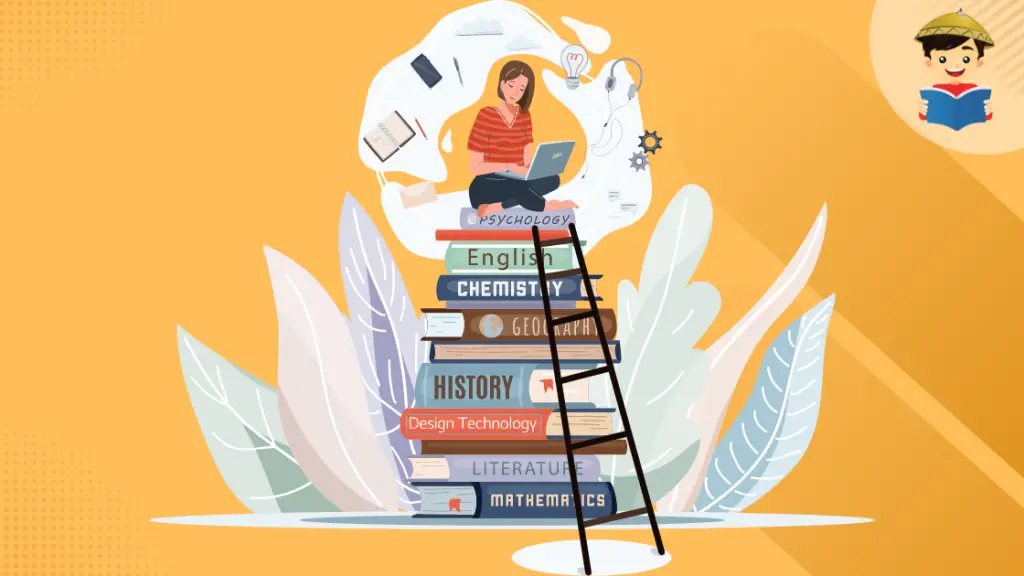
A scholarship application letter is a formal document that convinces the recipient that the sender is the best pick for the scholarship. It highlights the applicant’s qualifications, achievements, and experiences to ace the grant.
The application letter also states your reasons for applying for the scholarship, as well as an explanation of how the grant will help in your studies.
To add a “personal touch” to this letter, you may use personal anecdotes and testimonials. However, the letter’s tone should be formal rather than casual because it is an academic/professional document.
Although both documents increase your chances of getting the grant, they convey different messages.
A scholarship application letter convinces the reader that you’re an exceptional candidate for the scholarship grant. Specifically, it highlights the most compelling reasons why you deserve the scholarship. You can focus on your academic achievements, socioeconomic condition, or personal attributes.
This letter may include personal anecdotes, testimonials, and other supporting information that will help with your application. You may even state who your role model is and how they influence your passion to achieve your dreams.
Meanwhile, the main focus of an LOI is to express your interest in applying for a scholarship. Your qualifications, experiences, and socioeconomic conditions are stated briefly as supporting details. For this reason, an LOI is usually shorter, more straightforward, and has less room for personal anecdotes.
There are also some differences between their structure. The upper part of a scholarship application letter indicates your details (name, address, contact details). In an LOI, this part is usually located at the bottom.
A scholarship essay usually asks a particular question like, “Why do you deserve the scholarship?” , “How can our scholarship help you?” or “Who is your biggest inspiration?” It’s important in a scholarship essay that your answer is well-thought-out, clear, and creative.
Meanwhile, a scholarship application letter is more of an extension of your documentary requirements. It expounds the details indicated to highlight your best attributes so that the scholarship committee will pick you. The topic of the letter is “you,” and there’s no question you’re supposed to answer.
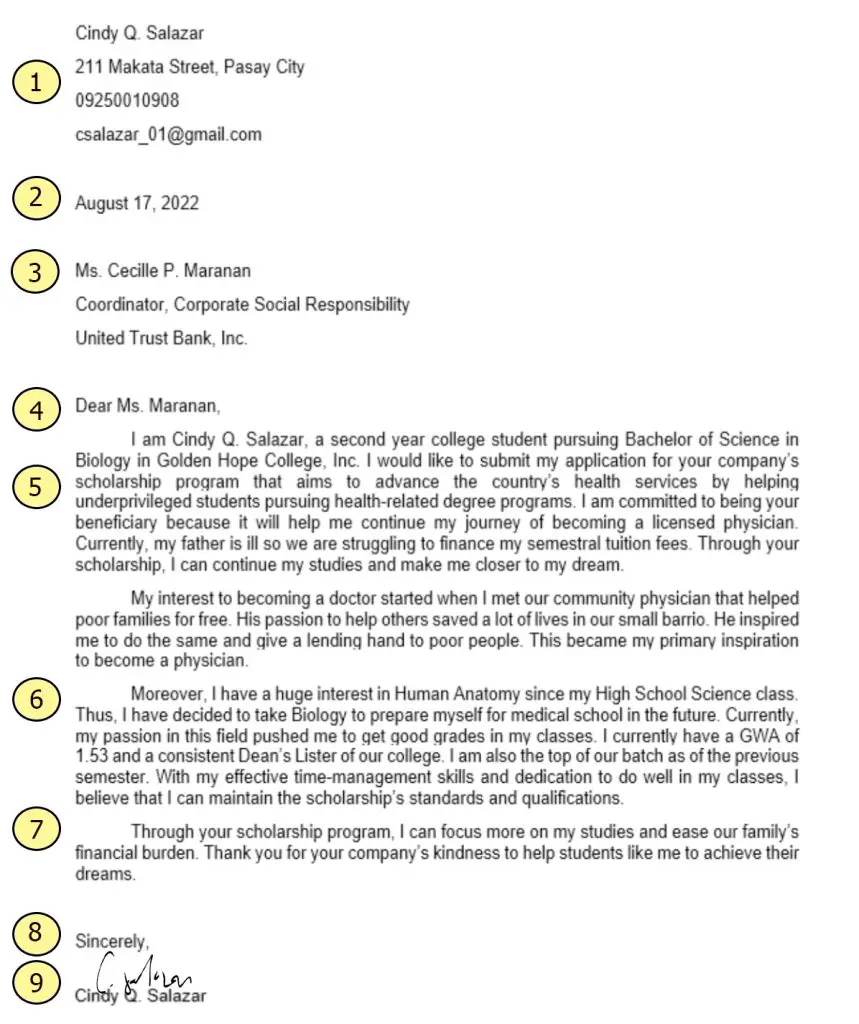
1. Personal Information : Located at the top of the letter, this section is where you indicate your full name, address, and contact details.
2. Date: The date when the letter is submitted
3. Recipient: This is where you indicate the name, position, and institution/company of the letter’s recipient
4. Salutation: If the recipient’s name is unspecified, you may use the line “To whom it may concern”
5. Introduction: This part includes your name and current educational attainment, as well as a brief statement of your desire to apply for a scholarship and the reason/s behind it
6. Body of the letter: This part highlights everything that makes you deserving of a scholarship (e.g., personal attributes, academic achievements, extra-curricular activities, etc.). It may also include personal anecdotes and testimonials.
7. Conclusion: This section is where you express your gratitude to the recipient and emphasize how the grant will help you in your studies.
8. Closing Remark: A short formal closing statement (e.g., Regards, Sincerely, etc.)
9. Signature
How To Write a Scholarship Application Letter
There are two reasons why you need to do this before drafting your letter.
First, to avoid stating wrong information in the letter.
Second, to help you decide what your “focus” is so that the letter will suit the scholarship requirements. Suppose the grant requires the applicant to have exceptional leadership skills. To meet this qualification, you need to brush up on your memory for any leadership roles you had in the school and include them in your letter.
Your letterhead should contain three sections: your details (name, address, and contact info), the date when the letter is submitted, and your recipient’s details.
Afterward, provide a short salutation like “Dear <insert name>” and “Greetings <insert name> .
Performing this step completes your letter’s introduction. In case you’ve recently graduated, mention your alma mater.
Don’t forget to mention in this portion your understanding of the scholarship’s goal and how it is aligned with your aspirations and current circumstance.
In the example above, the sender wrote that the scholarship aims to help underprivileged students pursuing health-related courses. Thus, she wrote that her dream of becoming a physician led her to major in Biology.
Finally, state your reason for applying for a scholarship.
Your goal in this step is to complete your letter’s body. State here your best attributes that make you stand out from other applicants. It depends on you how many paragraphs you’ll write for this section.
Here is some information you can include in your letter’s body:
- Academic achievements (e.g., consistent Dean’s lister, class valedictorian/salutatorian, academic honors like Best in Math or Best Research Paper, or high GWA , etc.)
- Extra-curricular experiences (e.g., leadership roles in the Student Council, student organizations, and NGOs, as well as awards received from competitions, etc.)
- Certifications (e.g., TESDA National Certificate)
- Work and internship experiences
- Personal attributes (e.g., interpersonal skills, time-management skills, perseverance, etc.)
- Other information that may suit the scholarship requirements. For example, if you’re applying for sports-related grants, you can mention the competitions you’ve won, your experiences as a student-athlete from another school, etc.
Only select attributes that are related to the scholarship’s requirements. For example, if they are looking for good academic standing, you must focus on featuring your grades and academic achievements. If the grant is looking for leadership skills, then highlight your leadership roles in student clubs or even in non-academic organizations.
You may also add personal anecdotes in this portion. For instance, the sender of the sample letter above shares her experience meeting a doctor who inspired him to pursue the same profession.
Briefly mention that the scholarship will help you accomplish your studies and ease your family’s financial burden. Afterward, thank the recipient for taking the time to read your letter.
Close your letter by adding a closing remark (e.g., Regards, Sincerely, etc.) and affixing your signature.
- Strictly follow the required word count, if there’s any. To save time reading tons of letters that scholarship committees receive, they set word count limits that applicants should follow. Hence, no need to make your application letter wordy; as long as it contains the most essential details, that would be enough. As the saying goes, “brevity is the soul of wit.”
- Be truthful. Do not include misleading information to stand out from the competition. Some scholarship committees conduct cross-checking to verify the information indicated in application letters. Get caught and lose your chance to enjoy the grant.
- Don’t be “too emotional.” It’s true that your letter becomes more convincing if you state your challenges and economic hardships. However, over-relying on “emotional appeal” might repulse your reader. Thus, avoid oversharing private matters in your letter. Moreover, refrain from adding “rant” statements (e.g., education is for the privileged only, tuition hikes are anti-poor, etc. ) in your letter. There’s a different avenue to express those frustrations.
Written by Jewel Kyle Fabula
in Career and Education , Juander How
Jewel Kyle Fabula
Jewel Kyle Fabula is a Bachelor of Science in Economics student at the University of the Philippines Diliman. His passion for learning mathematics developed as he competed in some mathematics competitions during his Junior High School years. He loves cats, playing video games, and listening to music.
Browse all articles written by Jewel Kyle Fabula
Copyright Notice
All materials contained on this site are protected by the Republic of the Philippines copyright law and may not be reproduced, distributed, transmitted, displayed, published, or broadcast without the prior written permission of filipiknow.net or in the case of third party materials, the owner of that content. You may not alter or remove any trademark, copyright, or other notice from copies of the content. Be warned that we have already reported and helped terminate several websites and YouTube channels for blatantly stealing our content. If you wish to use filipiknow.net content for commercial purposes, such as for content syndication, etc., please contact us at legal(at)filipiknow(dot)net
Letter to My High School Self
Back to Blog
Senior year is full of memories that you will cherish for the rest of your life. It’s a time to remember how the past four years have impacted your life. It’s an opportunity to thank those who have shaped your character—your family, friends, teachers, coaches, and other loved ones. It’s a season to plan for the future.
For our graduating Mercerians, the next step might be starting graduate school, completing an internship, or landing their dream job. For you, it’s becoming a Mercer Bear. Mercer is a place for you to grow, thrive, and discover your potential. To meet new people. To challenge yourself to be the best you can be. Get ready…because the next four years are going to be your most transformative yet.
Take advice from three Mercer seniors as they write letters to their high school selves and and offer words of wisdom about the transition from high school to college.
Senior Reflections
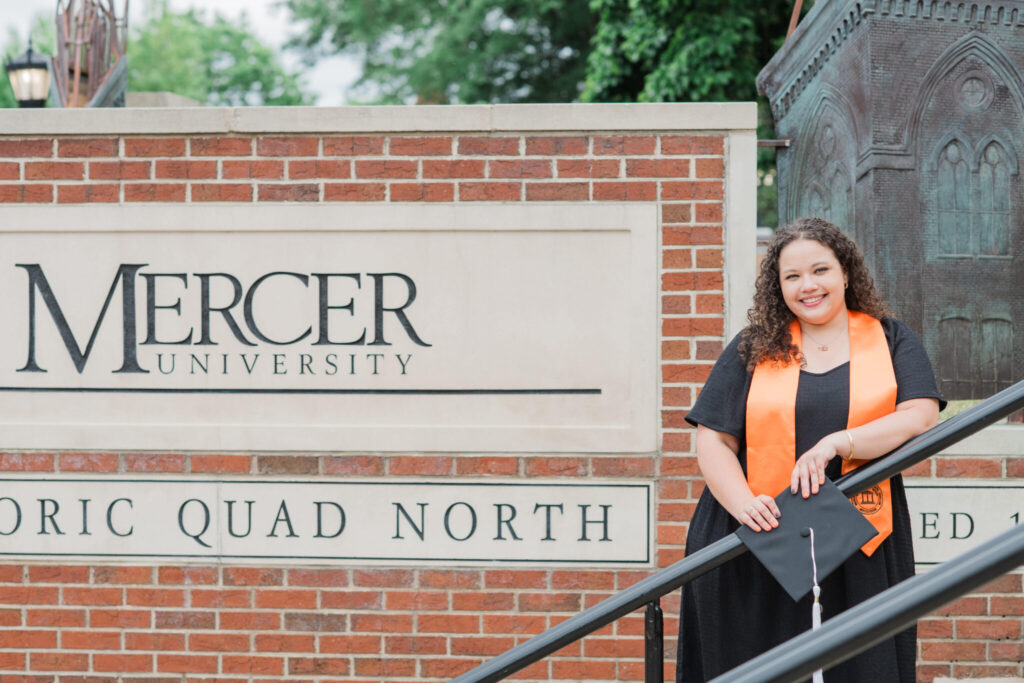
DIANA MARIE TEJERA BERRIOS
Major : Biochemistry and Spanish
“You were always told to find a college that feels like your home away from home. Well, Mercer became your home, and the people here became your family. ”
Letter to High School Diana:
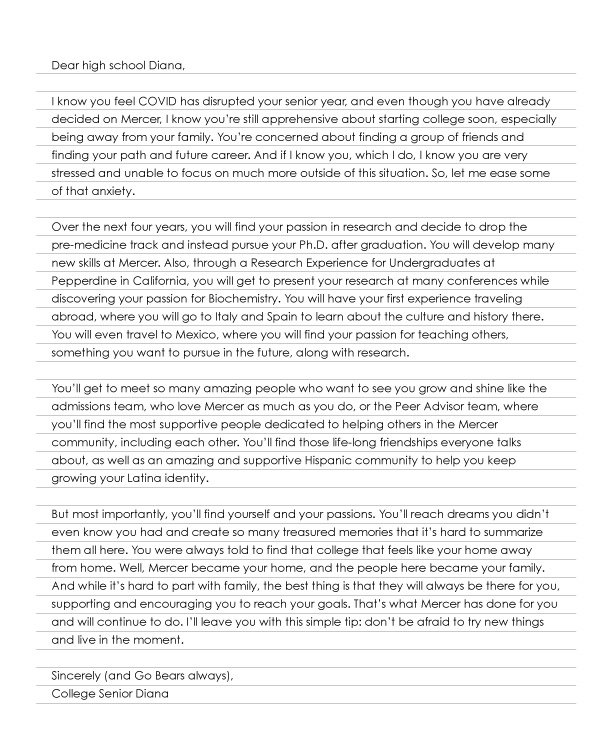
Austin Naab
Major: Media Studies and Business Administration
“From the moment you first step on campus, you'll see there is a community here unlike anywhere else”
Letter to High School Austin:
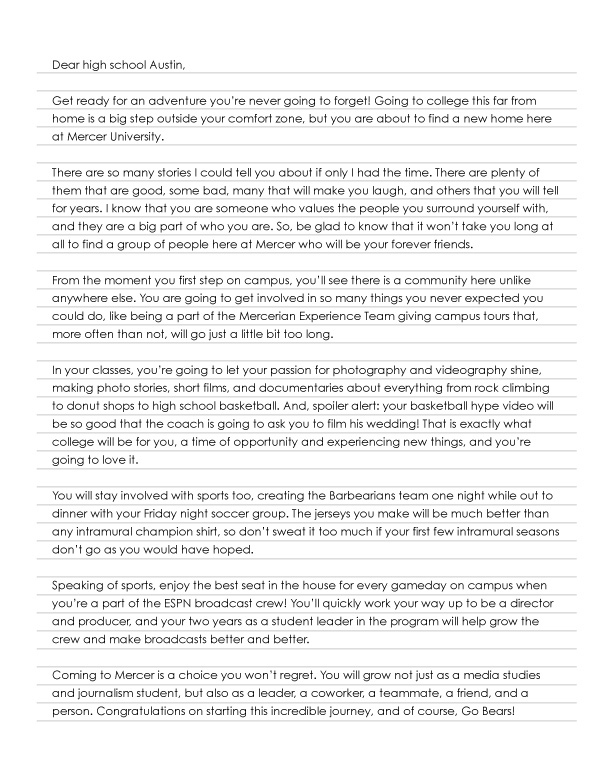
Seiler Rivers
Major: Computer Science and Music
“Though you may not see it now, Mercer will become a place that is unbelievably hard to leave behind.”
Letter to High School Seiler:
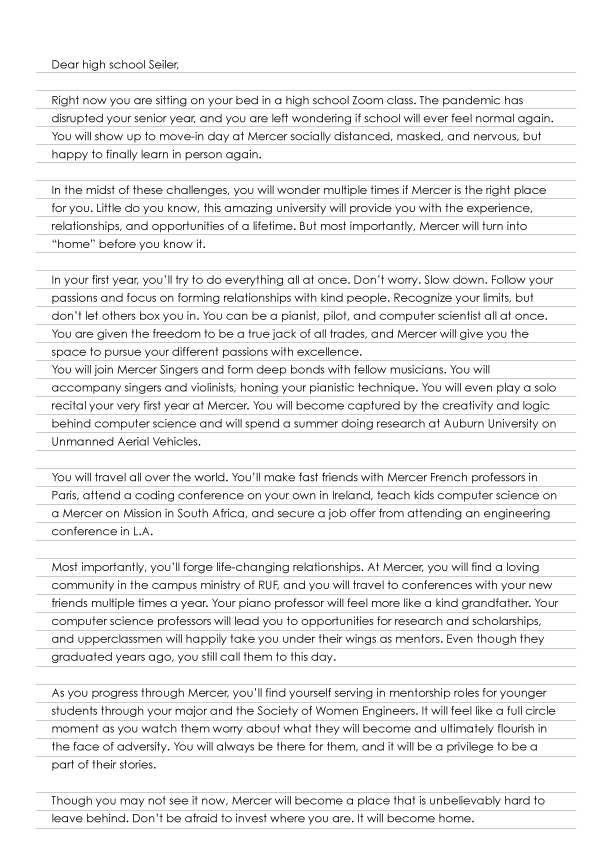
Share This Article
You may also like....

Housing Photos

Scholarship Interview Tips
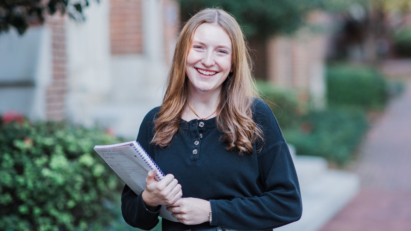
Discovering Higher Education
How to Get Accepted to Multiple Top Business Schools
Maximize every opportunity to emphasize the unique contributions you can bring to an MBA class.
Get Accepted to Multiple Top B-schools

Getty Images
When applying, it's important tailor your application to each school and have well-developed goal statement that plots the intended career path, experts say.
Nikita Srivastava applied to seven MBA programs and got admitted to three: Yale University School of Management in Connecticut, New York University's Stern School of Business and the University of Chicago's Booth School of Business in Illinois.
“I definitely was not expecting it,” says Srivastava, who chose Booth.
She attributes her multiple acceptances to top B-schools to tying her personal and professional backgrounds to her post-MBA goals. Her background was mainly in communications, media relations and public relations, and she credits her MBA admissions consultant for showing her how to tell her story.
“Lean into what makes you unique," Srivastava advises MBA applicants . " Think about how this unique quality will enhance the classroom for your peers and professors. Be proud of it and own it.”
Being accepted into multiple B-schools can allow an applicant to weigh program fit, potential opportunities and scholarship offers. Here are some things to consider to increase your chances of being accepted to multiple top business schools .
Apply More Broadly
Getting admitted to numerous MBA programs is a numbers game, says Sam Weeks, an MBA admissions consultant and founder of Sam Weeks Consulting.
“The more business schools a prospective applicant applies to, the more likely they are to be accepted into more than one school. That’s why we recommend to our clients to apply to at least six schools, if possible,” says Weeks, who has an MBA from the University of Oxford in England.
Students should not only apply to more schools to increase their chances of multiple admissions, but also more broadly in terms of school selectivity, experts say.
“This sounds obvious, but there are many applicants who go into this process only considering a limited set of schools with slimmer acceptance odds. They say the ROI is not there for other schools outside their ambitious targeting,” says Alex Leventhal, an MBA admissions consultant at Prep MBA Admissions Consulting.
Leventhal, who has an MBA from Harvard University Business School in Massachusetts, contends that the return on investment is compelling at more schools than most people think. He says applicants should look at the salary data of program graduates and the percentage of graduates who got jobs within three months after graduation.
“For example, the very top consulting firms recruit at a range of schools, and not just the top three,” Leventhal says.
He also suggests looking for joint degree programs to increase your odds by applying to a specialty track that a school is promoting or trying to fill.
Leventhal said he has had "some less-than-stellar clients" get accepted to the University of Pennsylvania's Wharton School , likely because they applied to the Lauder Institute of Management and International Studies joint program "for one of their less popular regional tracks. Or a client who got into Stanford Graduate School of Business because their professional experiences fit so nicely with a limited scholarship program focusing on the sustainable food supply chain.”
Customize Each Application
Schools like to see B-school applicants demonstrate familiarity with their programs, experts say. Leventhal says schools will “look for evidence that you have engaged with their program and talked to current students and alumni.”
Applicants should demonstrate they took the time to research a particular school “and all it has to offer, and consider both what they will learn from the program and how they will add value on campus,” says MBA consultant Scott Edinburgh, founder of Personal MBA Coach.
This means taking time to develop a strong personal story that connects past choices with future goals, says Edinburgh, who has an MBA from Wharton.
Applicants should demonstrate four key things in their tailored applications, he says: “Ability to handle the academic rigor of the target MBA program, leadership potential, how they will uniquely add value on campus and clarity of purpose.”
When applying, Weeks says, it’s important to have a well-developed goal statement that “charts out the applicant's intended career path and the impact they expect to have in their career.” He says those goals should be ambitious but attainable and make sense for the applicant.
Knowing what makes top business schools distinct "and then showing how you fit into those unique scenarios is essential to securing admits,” says Candy Lee LaBalle, an MBA admissions expert and founder of mbaClarity, formerly LaBalle Admissions.
Highlight Extracurricular Activities
Professional accomplishments that demonstrate leadership are great but shouldn’t be the only things highlighted. Edinburgh says applicants should show a passion for driving change.
“Successful MBA applicants are interesting people with plans to leave the world better than they found it in unique ways. Demonstrating passion and a track record of success in working towards this passion goes a long way,” Edinburgh says.
LaBalle says applicants who get admitted to multiple top B-schools tend to be “genuinely curious about the world, about learning, about having their perspectives challenged, and that shows in their hobbies and interests, work and goals.” They care deeply about the world and can demonstrate it, she adds, “whether that is mentoring classmates or starting an NGO that feeds thousands, and everything in between.”
Boost Your GMAT or GRE Score
If your GMAT or GRE score is lower than you had hoped for, take some more time to study and retake the exam.
“It is easier to get admits, and thus multiple admits, if your test score is strong and balanced between quantitative and verbal,” LaBalle says.
She says a strong, above-average test score can make a difference. “While there are many ways to offset a lowish test, the hard truth is that the higher your score, the better your odds of multiple admits.”
Students who don’t do well in the quantitative or analytical parts of the GMAT may prefer to take the GRE. Some business schools accept either test for MBA admissions.
Tests and other application materials aside, experts say securing strong letters of recommendation by supporters invested in your career and future is important to getting accepted to top MBA programs.
Apply to Schools Offering Scholarships
Applying to more schools can mean more scholarships that come with those admissions, which can give you options. Leventhal says his clients have focused on applying to more B-schools the last few cycles because they are increasingly interested in merit scholarships.
“The schools are trying to secure talented applicants with money off the tuition. As the price tag of the MBA has gone up, the merit pull can understandably matter. And schools that are reaches for an applicant generally won’t offer much in the way of merit grants,” Leventhal says.
Srivastava says she received some scholarships with each admissions offer, helping to relieve the burden of paying back student loans after graduation and giving her “freedom to focus on finding a career that would be a good fit for me both personally and professionally.”
A major bonus to getting accepted to multiple B-schools that offer scholarships is leverage, Weeks says. “You are in a strong position to negotiate scholarships.”
That includes awards at the most elite business schools. Students with more than one acceptance can inform schools that they received another offer and ask if any additional scholarship funding is available, he says.
Boost the Odds of MBA Acceptance

Tags: MBAs , Online MBA , business school , business , graduate schools , education , students
Applying By Program
Top Business Schools

Top Law Schools

Top Medical Schools

You May Also Like
A guide to executive mba degrees.
Ilana Kowarski and Cole Claybourn May 24, 2024

How to Choose a Civil Rights Law School
Anayat Durrani May 22, 2024

Avoid Procrastinating in Medical School
Kathleen Franco, M.D., M.S. May 21, 2024

Good Law School Recommendation Letters
Gabriel Kuris May 20, 2024

Premeds and Emerging Medical Research
Zach Grimmett May 14, 2024

How to Get a Perfect Score on the LSAT
Gabriel Kuris May 13, 2024

Premeds Take 5 Public Health Courses
Rachel Rizal May 7, 2024

Fortune 500 CEOs With a Law Degree
Cole Claybourn May 7, 2024

Why It's Hard to Get Into Med School
A.R. Cabral May 6, 2024

Pros, Cons of Unaccredited Law Schools
Gabriel Kuris May 6, 2024


Council of Presidents

A Letter to High School Principals and Counselors Regarding the FAFSA

Dear high school principals and counselors,
As we wrap up the 2023-24 school year, we extend our heartfelt thanks for your dedication to guiding and mentoring students as they move beyond high school. From offering dual-credit opportunities to preparing graduates for college-level studies, your schools serve as crucial launching pads into higher education. Your students are our students, and so we write to seek your partnership in these essential last weeks of the school year.
A request regarding the FAFSA
Education beyond high school — whether that be an apprenticeship, certificate, associate degree, or bachelor’s degree — puts students in the best position to get well-paying jobs and keep those jobs. To make that a reality, we come together to rally behind a shared cause: encouraging students and families to complete the Free Application for Federal Student Aid (FAFSA). This revamped financial aid form, the most significant update since the 1980s, promises to expand access to federal Pell Grants and other forms of assistance for thousands of low-income students. Additionally, it unlocks opportunities for the Washington College Grant, among the nation’s most generous state financial aid programs.
Delays and technical issues with the new FAFSA are causing many students to become frustrated and even wait to apply for financial aid and college. As you know, students who delay their education beyond high school are more likely to not go at all, ultimately putting their long-term financial and social stability at risk.
As the U.S. Department of Education continues to work on fixes to the FAFSA and information it shares with colleges and universities, our campuses are working together to help students complete their FAFSAs and pursue their dreams for higher education. Washington’s public and most not-for-profit, private four-year colleges and universities in the state have extended college decision day to June 1, 2024 to provide students more time to navigate the FAFSA process and make informed decisions about where to enroll. Community and technical colleges and other colleges and universities are also:
- Engaging with local high schools on events such as “FAFSA nights”;
- Messaging to students who have applied for college and students who are already enrolled;
- Participating in statewide initiatives to increase FAFSA completion rates; and
- Creating toolkits, webinars, and resource pages to help college financial aid officers navigate the new FAFSA.
Ways to help as a high school principal or counselor
New research from the Gates Foundation, HCM Strategists, and Edge Research shows that students trust their principals, counselors, and teachers. Forbes magazine summed it up this way:
“High school students are more likely to be exposed to positive information about college through school counselors, parents, college web sites and teachers. Whereas non-degree high school graduates [people who graduated from high school but did not pursue a college degree] are more likely to receive mixed messages … In other words, high school students are inside the college information pipeline, engaging primarily with educators who advocate for college degrees.”
As high school principals and counselors, you wield immense influence in shaping students’ educational journeys. We invite you to join us in:
- Letting students know there is a place for them at Washington’s colleges and universities, whether they want to earn a 2-year degree, a 4-year degree, train for a specific career in the skilled trades or become an apprentice. Washington’s community and technical colleges are open-door institutions, which means that applicants are automatically accepted. Through the Washington Guaranteed Admissions Program (WAGAP) or other direct admission programs, Washington’s public universities and some private, not-for-profit campuses have seamless pathways to higher education.
- Informing students about the Washington College Grant , one of the most generous and flexible financial aid programs in the country. Students and families can even get an estimate of their potential awards on the Washington Student Achievement Council website .
- Persuading students to complete a FAFSA or WASFA (Washington Application for State Financial Aid, for people who are undocumented or who do not qualify for federal financial aid but may qualify for state aid.) You can find your school’s FAFSA completion rates on the Washington Student Achievement Council’s FAFSA Completion Dashboard .
- Recommending that students and their parents or guardians sign up for the state’s college text messaging service called OtterBot for helpful reminders, resources, and encouragement. Students should text “Hi OtterBot” to 360-928-7281 and parents or guardians should text “Hi OtterBot” to 360-634-0354.
- Encouraging students to stick with it! The U.S. Department of Education is working hard to fix technical issues, and many have been resolved. By completing the FAFSA, students can open the doors to education and training that will improve their economic and social mobility for the rest of their lives.
Thank you for your partnership and your unwavering dedication to the success and well-being of students, now and in the future.
Ruben Flores , Executive Director of the Council of Presidents ;
Paul Francis , Executive Director of the Washington State Board for Community and Technical Colleges ;
Terri Standish-Kuon , President and CEO of Independent Colleges of Washington
To receive the latest Council of Presidents news in your inbox, enter your email address below.
Type your email…
Share this:
- Click to share on Twitter (Opens in new window)
- Click to share on Facebook (Opens in new window)
- Click to share on LinkedIn (Opens in new window)
- Click to email a link to a friend (Opens in new window)
More From Forbes
How high school parents can stay calm as their kids apply to college.
- Share to Facebook
- Share to Twitter
- Share to Linkedin
If you’re the parent of a high schooler who will begin the arduous college application process this fall, you have good reason to feel stressed.
First there was the pandemic, and all the online havoc that it evoked. Then Harvard racked up a record-low 3.19% acceptance rate in 2022 as test optional policies adopted by universities during the pandemic led to a tsunami of applications. In the last admissions cycle for fall 2024, over 170,000 students applied to UCLA. Another 118,000 applied to New York University and 105,000 applied to the University of Michigan. In fact, NYU’s acceptance rate went from a reasonable 35% percent in 2012 to an exclusive 8% today.
Applying to college can be stressful for students and parents. But in terms of lifetime earnings, a ... [+] university degree holds value.
Then there was the botched rollout of a new Free Application for Federal Student Aid. That made the difficult process of getting financial aid even more difficult.
Then campus protests about the war in Gaza erupted across the country, with students, faculty, administrations and donors finding themselves on opposite sides of the ideological fence. The fallout has hurt everyone.
All of these developments makes the “Varsity Blues” scandal in 2019, a nationwide conspiracy to buy admission to prestigious universities, seem almost quaint.
Fortnite Servers Are Down Here s When Chapter 5 Season 3 Begins Updated
Here’s what happens if trump is convicted—as trial goes to jury next week, ukrainian crews got tired of asking the americans for extra armor for their m 1 tanks they installed their own armor instead.
Well, here’s some surprising news for you – things will get better.
Why? Because competition – to a degree – is easing and the importance of brand is finally easing.
We live in an era of ideas and innovation. And, because of that, employers are shifting their focus from pedigree to skills and competencies , especially in areas where demand outweighs supply. For example, there are currently around 3.5 million unfilled jobs in cybersecurity globally, including an estimated 750,000 in the United States alone.
In addition, an engineering degree from a public flagship university may result in the same professional outcomes as an engineering degree from a pricey private school. Meaning, if you’re learning in-demand skills, you don’t need to go to a fancy school to get a high-paying job.
Students, too, can learn about those in-demand skills when deciding where to go to school rather than rely on rankings and brands. There’s the College Scorecard , an online tool from the U.S. government that provides data such as a university’s graduation and employment rate. In 2022, the scorecard expanded to include post-graduate average income and the percentage of graduates earning more money than people with a high school degree.
Georgetown University’s Center on Education and the Workforce (CEW) ranks 4,500 colleges based on their return on investment and even offers that rating from the perspective of low-income students. It examines the economic value of business, journalism, and communications programs as well.
So, instead of regarding college applications with stress and anxiety, students should view the process as a tool to help them achieve their longer-term goals.
With regard to competition, demographics are starting to work in favor of high school students applying to college. Universities are bracing themselves for the so-called enrollment cliff , a decline in the number of high school graduates. After the global recession of 2008, personal finance concerns triggered a fall in the birthrate and, 16 to 17 years later, fewer teenagers are graduating high school and aiming to go to college.
This shrinkage compounds an already existing decline in college enrollments, as more high school graduates opt to become job-ready by earning certificates or pursue vocational education . Except for the top 50 or so schools, universities are clamoring to keep their freshmen places filled. In fact, a number of universities are cutting budgets due to falling or flat enrollments and one college or university per week is announcing a merger or closure.
The demographic decline is another reason why the reinstatement of SAT requirements likely won’t go much further than the small group of schools such as Brown and Dartmouth that have the luxury of erecting academic and financial barriers to fend off the tidal wave of applications.
It’s important to remember that only a small percentage of undergraduate students attend Ivy League schools. This puts a lot of unnecessary pressure on the remaining students, who are made to feel anxious and inadequate in this hothouse environment. The Centers for Disease Control and Prevention has repeatedly shot off warning flares about the mental health of students going in the "wrong direction," with no pivot in sight. The pressure cooker of college applications has undoubtedly exacerbated the situation.
The college application process is also as selective as you make it. The average acceptance rate among all ranked colleges reporting their admissions information to U.S. News & World Report was 71.4% in 2022 and 37 schools said they accepted all applicants. So, the pressure imposed on students is arguably by choice, not necessity.
Meanwhile, a university education continues to have long-term value, regardless of where your child goes to school. According to State University of New York trustee Stanley S. Litow, college graduates will make $1 million more over a lifetime than workers with only a high school diploma, while the CEW estimates a bachelor’s degree is worth $2.8 million, on average, over a lifetime.
In other words, it’s worth the effort.
So, for those parents bracing for the worst, help your children become their best. And attending college is a way for that to happen.

- Editorial Standards
- Reprints & Permissions
Join The Conversation
One Community. Many Voices. Create a free account to share your thoughts.
Forbes Community Guidelines
Our community is about connecting people through open and thoughtful conversations. We want our readers to share their views and exchange ideas and facts in a safe space.
In order to do so, please follow the posting rules in our site's Terms of Service. We've summarized some of those key rules below. Simply put, keep it civil.
Your post will be rejected if we notice that it seems to contain:
- False or intentionally out-of-context or misleading information
- Insults, profanity, incoherent, obscene or inflammatory language or threats of any kind
- Attacks on the identity of other commenters or the article's author
- Content that otherwise violates our site's terms.
User accounts will be blocked if we notice or believe that users are engaged in:
- Continuous attempts to re-post comments that have been previously moderated/rejected
- Racist, sexist, homophobic or other discriminatory comments
- Attempts or tactics that put the site security at risk
- Actions that otherwise violate our site's terms.
So, how can you be a power user?
- Stay on topic and share your insights
- Feel free to be clear and thoughtful to get your point across
- ‘Like’ or ‘Dislike’ to show your point of view.
- Protect your community.
- Use the report tool to alert us when someone breaks the rules.
Thanks for reading our community guidelines. Please read the full list of posting rules found in our site's Terms of Service.

IMAGES
VIDEO
COMMENTS
Scholarship application letter example Here's an example of a scholarship application letter for you to review: Robert Malone 554-765-0088 | [email protected] | Boulder, CO Wellington Student Fund Dear Members of the Scholarship Review Committee, My name is Robert Malone, and I'm a high school senior at Mile High Academy. Next year, I plan to attend Open Range University and major in ...
The following parts make up an appealing scholarship application letter: First Part. Contact Information. Self Introduction and a Milestone achievement. Middle Part. Key details of you and reason why the committee should choose you. Expression of passion and reason why you want the scholarship. Last Part.
Example cover letter for a scholarship. Consider this example of a cover letter for a scholarship to help guide you as you write: Dear Ms. Adams, My name is Eloise Barone, and I'm writing to submit my application for the Ridge Hills University financial aid program for the spring 2024 semester. I'm currently a first-year student enrolled in the ...
The template below outlines the purpose for each paragraph and what it should include: Your Name. [Your phone number] [Your email address] [Your mailing address] [Date] [Scholarship organization name] [Organization address] [Organization phone number] Dear [Mr./Ms./Mx. Recipient's name] / [Scholarship Committee],
A scholarship application letter is a formal document where candidates can make a case for why they should receive academic funding from an institution, organization or individual. ... Read this strong sample scholarship letter for a high school student applying to a local community organization: Jennifer Smith 123-456-7890 [email protected ...
Application Letter Template for a Scholarship Request. Dear [Recipient's Name], I am writing to express my earnest interest in the [Scholarship Name] offered by [Institution or Foundation's Name]. As a dedicated student of [Your Field of Study], I am committed to my academic pursuits and am eager to overcome financial barriers to achieve my ...
A candidate justifies himself/herself as an outstanding student in overall studies and extracurricular activities to increase their chances of getting the scholarship through a scholarship application letter. Sections of a Scholarship Application Letter (Format) A scholarship cover letter should have different sections and paragraphs, with each ...
You will need to use your best judgment to write a concise motivation letter. The letter should include: The most important elements of your resume. Your education. Your professional experiences and plans for the future. Motivation letters are usually around 500-1,000 words. Split them into paragraphs for easy reading.
Scholarship Cover Letter Example. To Whom It May Concern, My name is Alex Smith and I am a high school senior in Bend, Ohio. In the fall of 2019, I will be starting my freshman year at the University of Pennsylvania at the Annenberg School of Communication with an intended major in communications.
Good luck writing your scholarship cover letter! Be sure to apply to all the scholarships you qualify for. Remember, there are scholarships for all demographics, including for women, high school seniors, and Black students. Some scholarships require essays and applications, but others are no-essay or easy to apply for scholarships. Remember ...
A scholarship application letter is a formal letter written by a student to an organization that provides financial assistance to support a student's education. Scholarships are available to students of all levels of education, from high school to postgraduate level.
Cement your worth in the middle of your cover letter for scholarship. Show off your personal attributes and end goals. Stay relevant to the program and show the committee the impact you'll make. Finish with a CTA. Ask the question and offer something in return. Get your application read and get that interview.
During my junior year of high school, I took four AP tests, two on the same day, and earned the AP Scholar with Honor Award. Additionally, I received the Letter of Commendation for the PSAT/NMSQT, and qualified for Rotary Top 100 Students both my freshman and senior year, a sign of my commitment to my studies.
The best way to do it is by including "Dear", then addressing the name of the committee with a Mr. or Ms. 3. Opening letter. Now is the time to get into your paragraphs of the scholarship cover letter. In this paragraph, you should make a brief introduction of yourself including your experience.
A scholarship letter should convey your qualifications, achievements, and goals clearly and concisely. A typical scholarship essay format consists of an introduction, 2 body paragraphs, and a conclusion, and should not be more than 500-750 words long, or one page in length. Here are the key components that should be included:
Scholarship cover letter example. Use this Scholarship cover letter example to finish your application and get hired fast - no frustration, no guesswork. This cover letter example is specifically designed for Scholarship positions in 2024. Take advantage of our sample sentences + expert guides to download the perfect cover letter in just minutes.
A fill-in-the-blanks template that will produce your cover letter for scholarship within 15 minutes. Save hours of work and get a cover letter like this. Pick a template, fill it in. Quick and easy. Choose from 18+ cover letter templates and download your cover letter now. Create your cover letter now.
There are two addresses in this letter. Start by placing your name, address, and date at the top of the letter. This is the first address. Kelly Brown, 556 Martin Luther St. Boston, MA 55647, (222)-322 5547. Date: 1st Dec 20XX.
1. General scholarship recommendation letter. This is a great sample scholarship letter if you're trying to offer a rounded view of a student's performance in high school. You'll include information about your experience with them as well as your thoughts on their potential success in a higher-education setting. 2.
Creative Scholarships. Artistically talented students could opt for a creative scholarship. Art is a vast topic, wherein music, dancing, sculpting, and other art forms are a part of. Sponsors often organize an audition for this type of scholarship. If you are an artist, then you qualify for this type of scholarship. 3.
To be eligible for the Lift Parts Express Scholarship a student must: 1) A Current Senior in High School or. 2) A Freshman or Sophomore in College/University. 3) Be a legal resident of the United States or Canada. 4) Enrolled or expected to be enrolled by the Fall of 2024. 5) Submit a completed online application form prior to the deadline.
Scholarship letter of application sample Here's an example of a scholarship letter of application that may help you when you're writing your own: Caroline Price 0132 465 375 [email protected] 15th June, 2022 Mr. M. Lucas Director of Scholarship Affairs Brisbane Family Technologies Dear Mr. Lucas, My name is Caroline Price and I have recently received an acceptance letter to the Upper Lake ...
As part of the application process, you'll likely submit materials beyond a standard application so the decision-makers can get to know all applicants and choose the right awardees. These can include: Personal statement or essay. High school transcripts or diploma. SAT or ACT scores. Resume. Financial information. Letter of recommendation
2. Complete the Letterhead and Provide a Short Salutation. Your letterhead should contain three sections: your details (name, address, and contact info), the date when the letter is submitted, and your recipient's details. Afterward, provide a short salutation like "Dear <insert name>" and "Greetings <insert name>. 3.
Adjusted combined federal household income of $125,000 or less. Pursuing an undergraduate degree at a SUNY or CUNY college or university. Enrolled in full-time study (at least 12 credits per term) Complete at least 30 credits per year. Live and work in New York State for a duration equal to the number of years you received the scholarship.
Letter to My High School Self. Senior year is full of memories that you will cherish for the rest of your life. It's a time to remember how the past four years have impacted your life. It's an opportunity to thank those who have shaped your character—your family, friends, teachers, coaches, and other loved ones.
Profile Example 2. High school student with recent formal experience helping care for toddlers. Dedicated to providing children with fun, educational indoor and outdoor activities. Bilingual: Fluent in English and Spanish. 2. Add a pertinent experience section. Your resume's experience section should center on your relevant duties, skills ...
Here are some tips to help law school applicants who aim for a score of 180 on the Law School Admission Test. Gabriel Kuris May 13, 2024 Premeds Take 5 Public Health Courses
A Letter to High School Principals and Counselors Regarding the FAFSA. Dear high school principals and counselors, As we wrap up the 2023-24 school year, we extend our heartfelt thanks for your dedication to guiding and mentoring students as they move beyond high school. From offering dual-credit opportunities to preparing graduates for college ...
In the last admissions cycle for fall 2024, over 170,000 students applied to UCLA. Another 118,000 applied to New York University and 105,000 applied to the University of Michigan. In fact, NYU ...